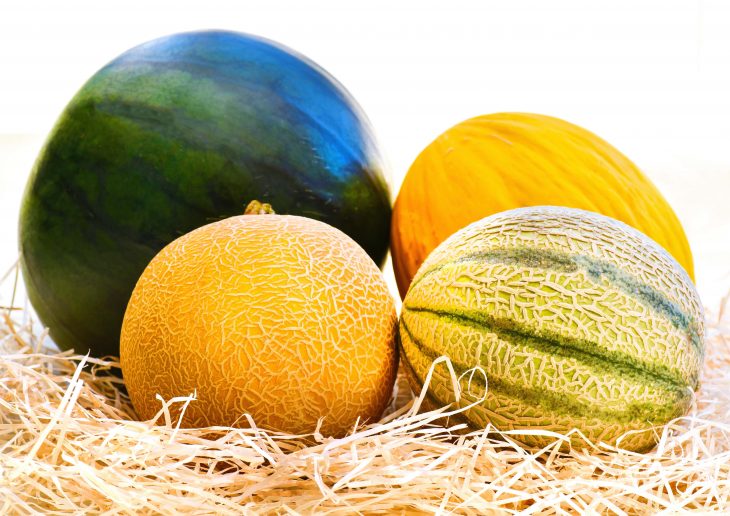
Have you ever wondered if there are other types of melons you haven’t heard about? When you imagine a melon, you might think about a specific melon like a golden melon, an orange melon, or a white melon. However, the kinds of melons available for you in our world are over 40 varieties!
There are two different types of melons in the world: natural melons and hybrid melons. Natural melons are those that weren’t created through selective breeding. Meanwhile, hybrid melons, such as the Picasso melon, were done through selective breeding or were genetically engineered. Botanists also classify them into three separate genera: Benincasa, Cucumis, and Citrullus. The Benincasa genus only has the winter melon. The Citrullus genus has fruits with a similar appearance to watermelons, while the Cucumis genus has the most culinary melons.
It might also surprise you to learn that there are different colors of melons. You can have a green melon, a yellow melon, and a red melon on your table and each one would have different flavors.
There are many popular questions surrounding melons like “what is a melon?” and “are melons fruit?” The answers to these questions are simple. Melons are fleshy fruits that can be eaten alone or incorporated into dishes. Some people might even have debates regarding the melon vs. cantaloupe. However, cantaloupes are actually melons!
The lack of information regarding melons comes is because of the lack of research and articles surrounding them. So we began our quest to learn the true definition of melons. The fun part about our research was getting to know all about the melons and their varieties. In addition, we also added the history of melons and the different types of melons for you to learn more about.
History of Melons
First, what is a melon? Melon is a fruit that sprouts from different plants. However, they can only be melons if these fruits are members of the gourd family, such as the watermelon or the muskmelon.
It was the African continent that first got a taste of melons. You can still find the descendants of the first melons in Africa in the wild. Scientists believe prehistoric men were the first to gather and save the seeds of the sweet melons to begin cultivation. Ancient Egyptians also cultivated melons around 4,000 years ago. Evidence is found on paintings of melons and seeds inside Ancient Egyptian tombs that archeologists discovered.
Russia, India, Iran, Afghanistan, China, Japan, and Iraq cultivated melons 1,000 years after the Ancient Egyptians. Meanwhile, Greeks and Romans were the first to cultivate melons in Europe after being exposed to Asian cultures. Haitians were the first in the new world to cultivate melons, who began the process in 1494. European figure Christopher Columbus introduced melons to the Haitians during his second voyage.
The Different Types of Melons in the World
Now that we know a great deal about melons, how about we start your journey with a few types of melons list? Here we have 41 melon varieties for you to learn about, a few pictures of melons, and a brief history of their uses and physical description.

Ananas Melon
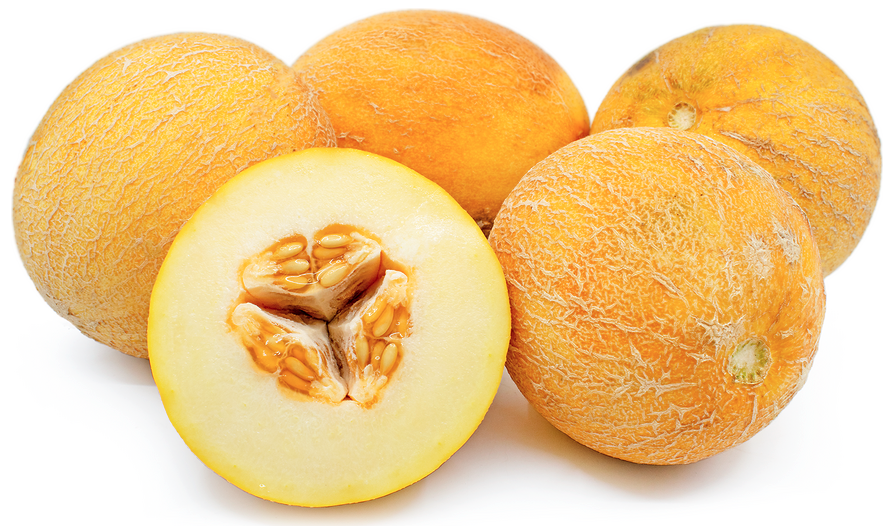
First on our list of the types of melons is a yellow melon named Ananas. These oval-shaped melons have sizes ranging from small to medium, measuring 12 to 17 centimeters in diameter. Its colors range from melon green to golden yellow (depending on its maturity.) Ananas melons cover themselves in tan netting and have ivory to pale yellow flesh.
Ananas melons have a unique scent that is like pineapples. Because of this, people named the melons ananas, which is a French and Italian word meaning pineapples. They belong to the reticulatus group, which are melons that cover themselves in rough netting.
You can only find Ananas melons through specialty growers, hence they are considered rare and seasonally found. Regardless of their rarity, people continue to use Ananas melons, as they suit salads and both sweet or savory dishes.
A fun fact about the Ananas melons is that they have even contributed to scientific progress. Thomas Jefferson’s estate in Monticello featured the Ananas melons and his detailed logs about the melons allowed a DNA project in Texas A&M to create a melon genome map to produce hybrid melons.
Apollo Melon
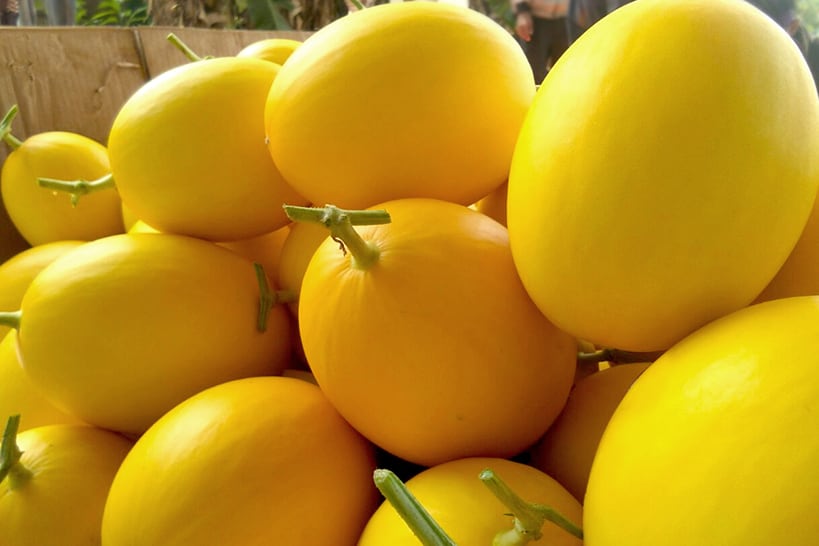
Next on the types of melons list is the Apollo melon. This yellow melon fruit has similar features to the Golden Langkawi melon. However, they have different skin surfaces. The Apollo melon has bright colors with webbed features. Meanwhile, the Golden Langkawi melon is smooth with light colors.
You can easily grow your own Apollo melons compared to other types of melons. Indonesian farmers widely cultivate the Apollo melon despite watermelons or honeydew melons being more popular than them. There are many great recipes for desserts, salads, and snacks when using Apollo melons. People like them because of their fiberless texture, extremely sweet flavors, and high water content.
Autumn Sweet Melon
Autumn Sweet melons are rare types of melons with circular bodies weighing an average of 2 to 4 pounds. They have smooth yellow skin that, when peeled, reveals white flesh. Autumn Sweet melons have sweet and tender flavors with high water content.
People call these fruits Autumn Sweet melons because of the season in which they ripen. These melons usually ripen during the mid-summer to fall season.
Autumn Sweet melons have the most suitable flavor for drinks, salads, and appetizers. You can make melon mint smoothies, cucumber melon salads, and mint julep melon bites with them. However, the Taiwanese also created many of their traditional dishes, such as soups and appetizers, with Autumn Sweet melons.
Bailan Melon
Up next on our list is the popular Bailan melon from Lanzhou, China. Bailan melons are also known as the Lanzhou honeydew melons. They are a variant of the honeydew melon with the same nutritious benefits.
Bailan melons have a wide variety of colors, such as yellow, orange, white, and green. The Bailan melon has a dense inner flesh. This makes the Bailan melons heavier to carry compared to other types of melons. However, just like other honeydew melons, the Bailan melon contains high amounts of Vitamin C and protein. Thus, Bailan melons are more notably known for improving digestion and cooling body temperatures.
You can find Bailan melons everywhere in Lanzhou, the capital city of the Gansu province. However, the melons themselves were actually a gift from Henry A. Wallace, former Vice President of the United States. Wallace donated the seeds in the 1940s after founding Pioneer Hi-Bred, a major seed company. His experience in agriculture inspired him to trade his beloved seeds to other countries. This is also the reason many Chinese refer to the Bailan melon as Hualaishi, which is an adapted form of Wallace.
Banana Melon
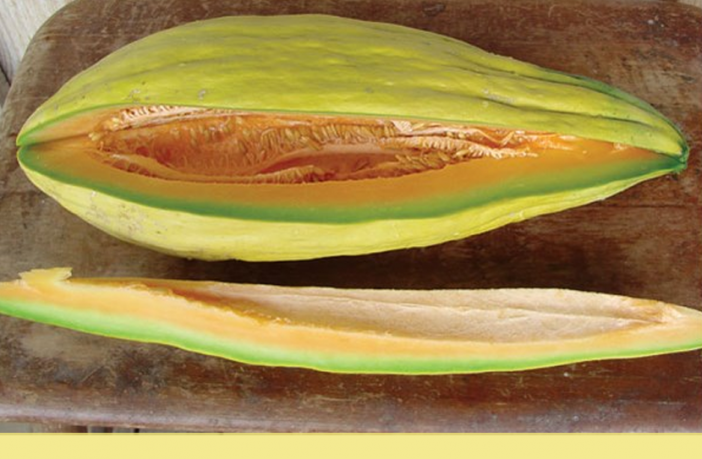
The Banana melon is one of the types of melons that have a unique appearance. The banana melon has a peach-orange-colored flesh with smooth yellow skin. Another unique thing about the banana melon is its flavor. You can taste spicy, savory, and sweet flavors all in its flesh.
You can usually find banana melons ranging from 4 inches in diameter up to a maximum of 20 inches. Banana melons also live longer than other melons. This makes it easier to travel with banana melons without them going bad immediately. However, it is important to note that banana melons grow better in their ideal environment: the Northern regions of the United States.
The banana melon first appeared in the United States around 1883, around the same time the Ananas melon was introduced. Banana melons are similar to what wild bananas used to look like and, just like the Ananas melon with pineapples, the banana melons also carry the same fragrance as bananas.
Bitter Melon
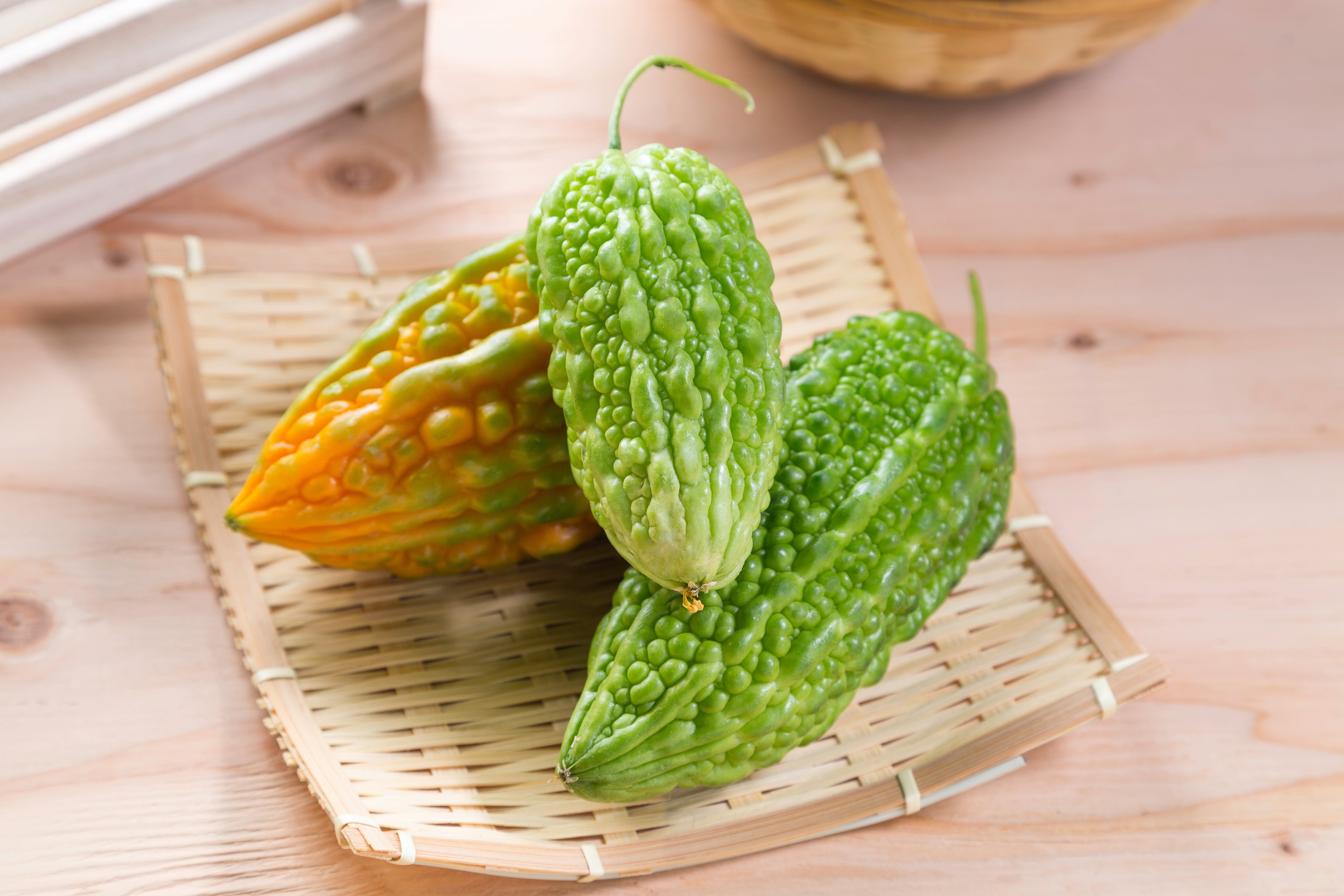
The bitter melon, also known as the Bitter gourd, is a melon originating from Asia. Despite being a member of the melon group filled with fruits, the bitter melon is actually a vegetable. You can find the bitter melon in Southeast Asia, East Africa, South America, and the Caribbean.
Bitter melons thrive in tropical climates and create bitter yet tropical flavors when ripened. Nutritionists believe them to be rich in vitamins A and C, which help in skin health, vision, bone formation, wound healing, and disease prevention.
You can consume bitter melons as tea, part of a dish, or even stir-fried. However, it is important to note that ingesting the seeds, extracts, or large quantities of bitter melon juice can cause indigestion or other negative effects.
You should also be aware not to confuse a bitter melon with an Ivy gourd. Many people confuse the two because of their similar tastes. However, Ivy gourds are known to help with constipation, weight loss, and high blood pressure. Meanwhile, bitter melons are known as natural insulins for diabetic patients.
Calabash Melon
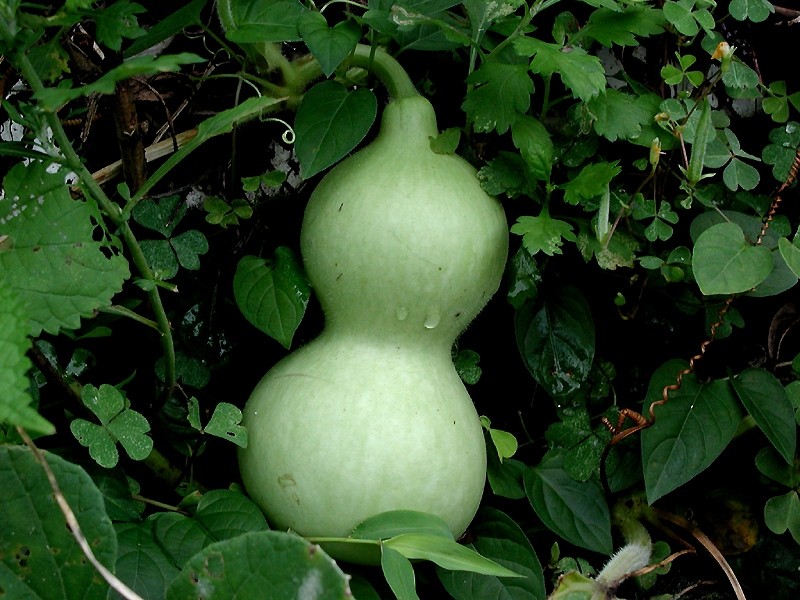
The calabash melons are next on our types of melons. You might also know them by different names, such as the white-flowered gourd, the birdhouse gourd, the Tasmania bean, the New Guinea bean, the bottle gourd, or the long melon.
Calabash melons grow from their vines to be harvested in two ways. The first method is to harvest them unripened and consume them as a vegetable. The second method is to harvest mature calabash melons. They are then dried and used as materials to make utensils, musical instruments, and even containers.
Contrary to its other nicknames, such as the long or bottle gourd, the calabash melons also come in different shapes, like a circle or serpentine. Interestingly, people usually call the extremely round calabash melons exclusively calabash gourds. These calabash gourds are actually one of the first plants people cultivated for containers and not food.
Camouflage Melon
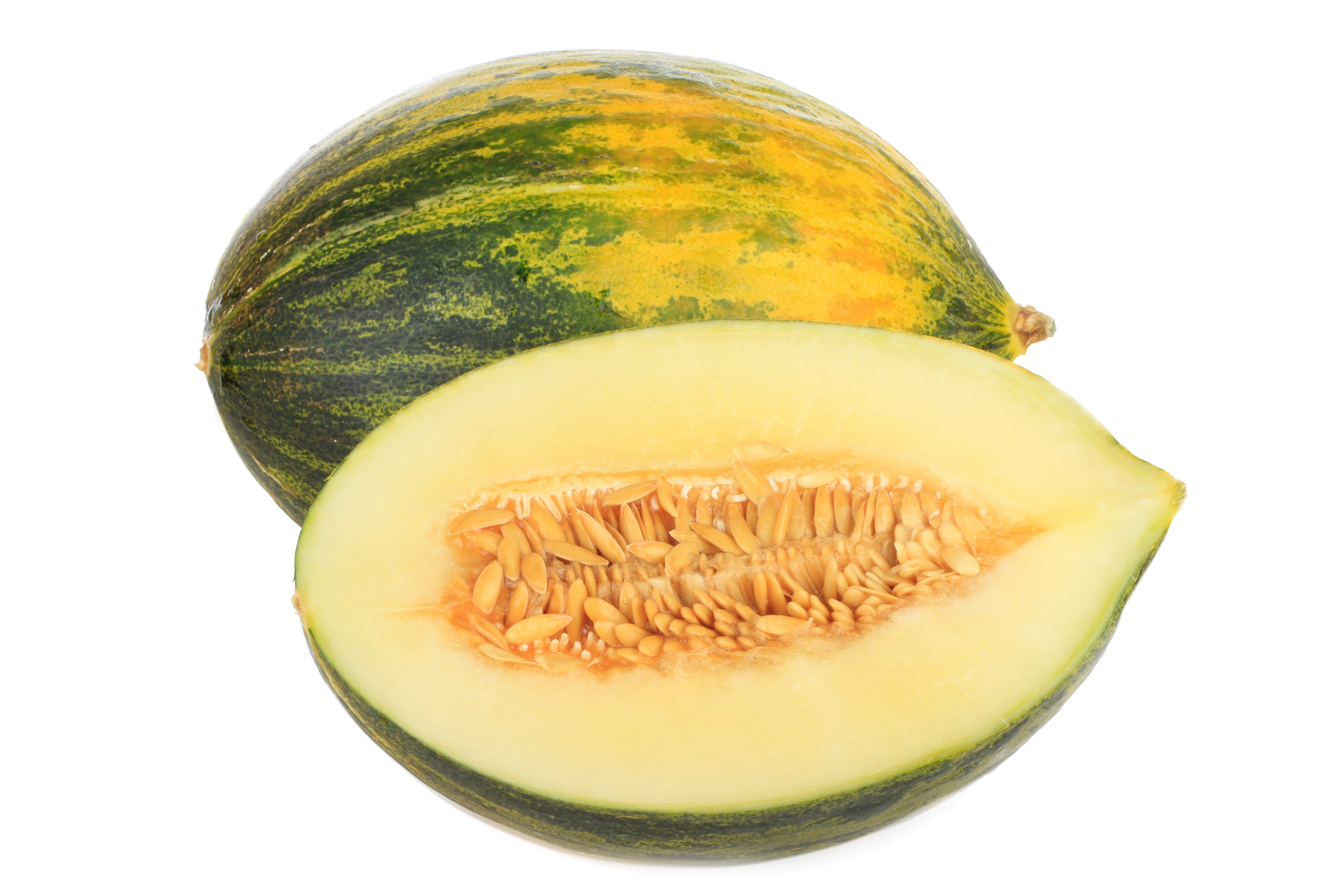
The Camouflage melon might be more difficult to find compared to other types of melons on this list. You might also know the Camouflage melon by other names: the Christmas melon, the Santa Claus melon, or the Toad Skin melon.
Camouflage melons are physically similar to watermelons. However, they taste more like honeydew melons. Camouflage melons have green blotched surfaces similar to toad skins, hence its nickname. While it may resemble the Canary melon in terms of shape, it is greener with mildly sweet flavors.
Camouflage melons last in storage longer than other fruits. That is why its other English nicknames, such as the Christmas melon or the Santa Claus melon, are referencing its ability to last up to Christmas.
Canary Melon
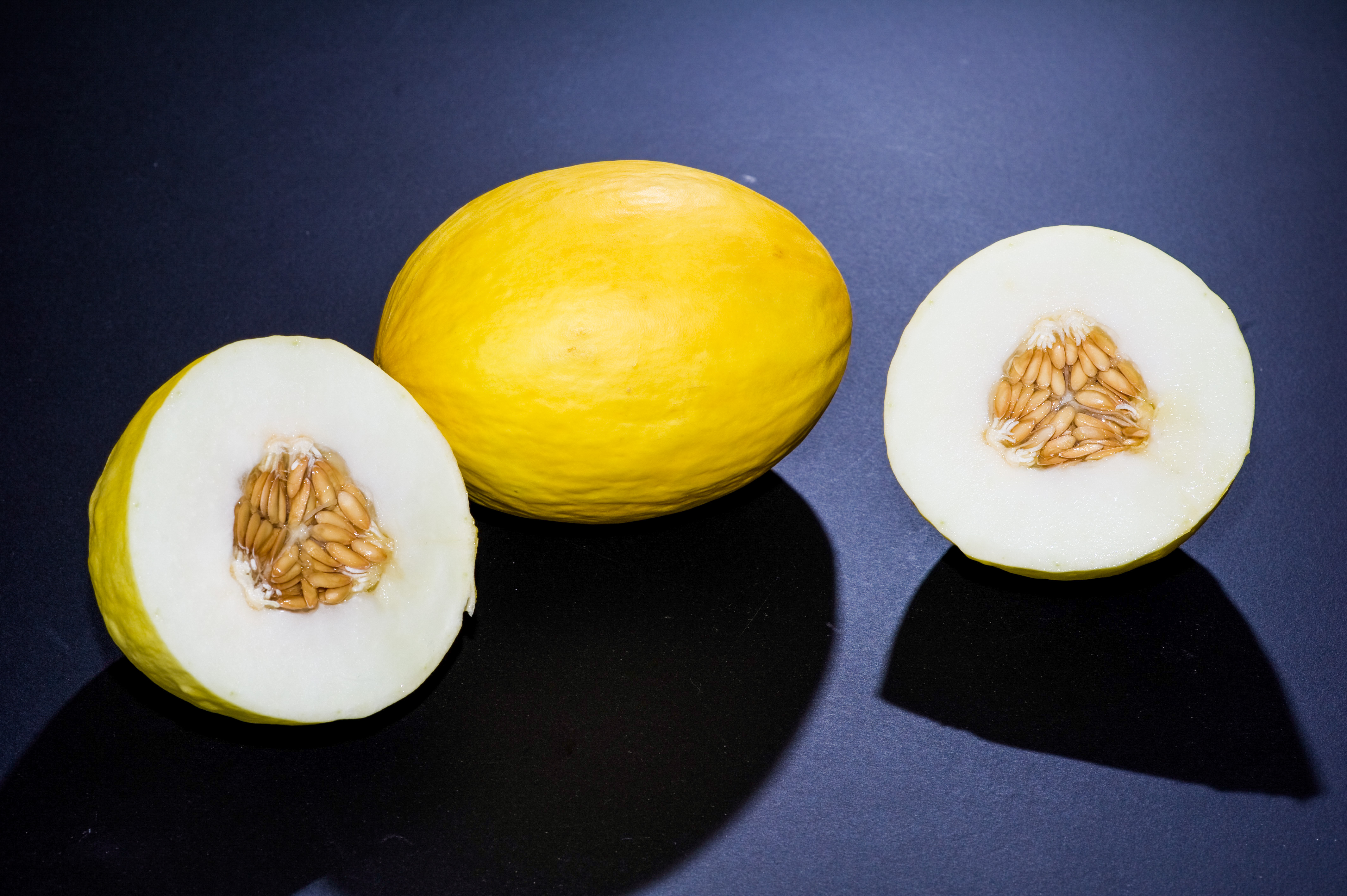
The Canary melon, also known as the Spanish melon or the Juan Canary melon, is next for our types of melons. These melons originated in Europe but are now more popular in South Korea and Japan. You can find them growing well in tropical climates such as San Joaquin, California, and Arizona too.
Canary melons have yellow rinds similar to the Canary bird, hence its name. They also have pale green or white inner flesh. They have two different flavors: the extremely sweet flavor and the mildly tangy flavor. People who have eaten Canary melons describe them to be like honeydew melons.
Canary melons are good for extended periods of storage, as their hard rind allows the flesh to stay unhurt. You can also count on Canary melons as a source of fiber. This is because Canary melons have an average of 10 grams, with each half-cup serving.
There are many ways to consume Canary melons. You can eat them freshly cut, mixed in with salads or juices, and even dried to serve as chips or snacks. The Canary melon seed can also be consumed after being dried, pressed into seed oil, or roasted.
Cantaloupe Melon
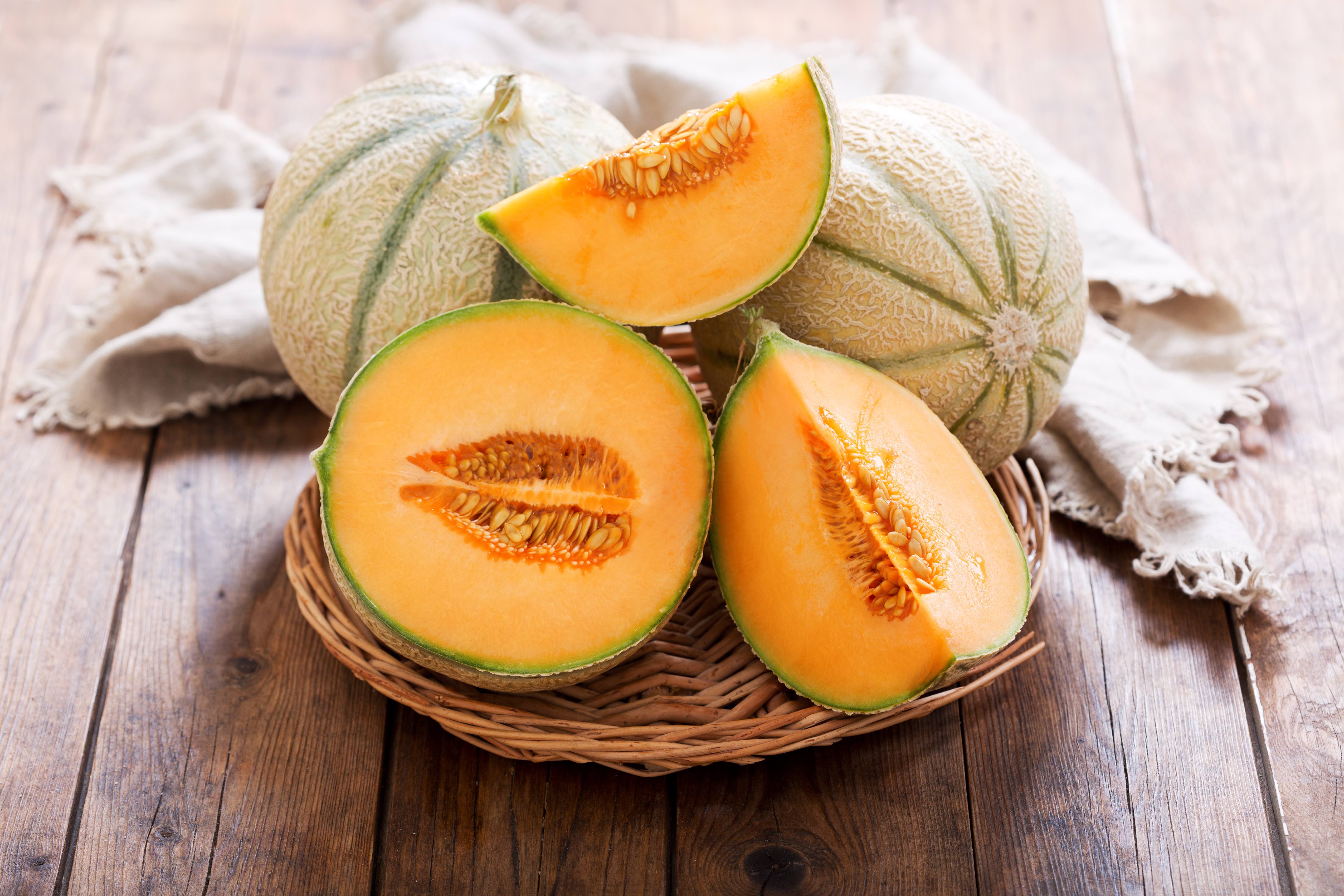
Have you heard about the melon vs. cantaloupe debate? What about the “is cantaloupe a fruit or vegetable” debate? What most people don’t know is that cantaloupes are part of the melon family. This misconception about cantaloupes is common, seeing as there is little research about cantaloupes. In fact, there are actually two types of cantaloupes in the world.
The cantaloupe melon, also known as the rock melon or sweet melon, has two variants: the European and the American version. American cantaloupes start as green cantaloupe, which then turn into yellow cantaloupe once ripened. Meanwhile, Europeans are more familiar with a beige and green cantaloupe.
Botanists and melon lovers agree that the original cantaloupe comes from Europe. While the American cantaloupe is actually a muskmelon. Gardeners have experienced difficulty in growing European cantaloupes. This makes the European cantaloupe rarer as mass-production for this variant is more challenging.
Casaba Melon
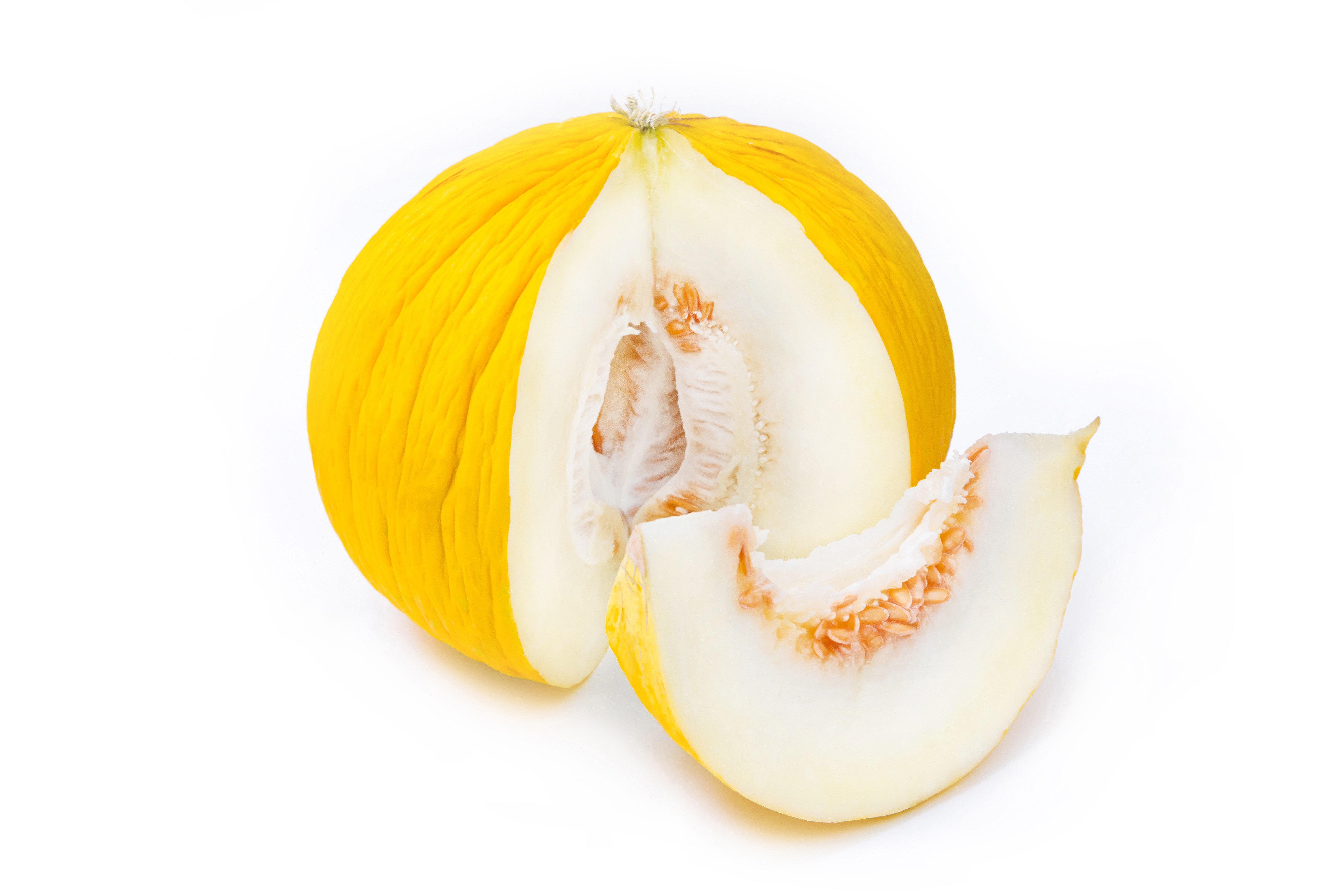
Casaba melons are yellow melons originating from Persia that are around 3 t0 8 lbs. in weight. Unlike other types of melons, the casaba melon comes in several shapes: oval, acorn, or round.
You can find many casaba melons during the late summer through the early winter season. They can grow in both hemispheres, increasing their durability. Casaba melons are widely found in the Imperial Valley of Southern California.
The melons first appeared to the Americans in the late 1900s as fruit from Kasaba, Turkey. As a result, they popularly named it the casaba melon. However, Persians were its first cultivators who were producing the casaba melon 1,000 years ago.
Charentais Melon
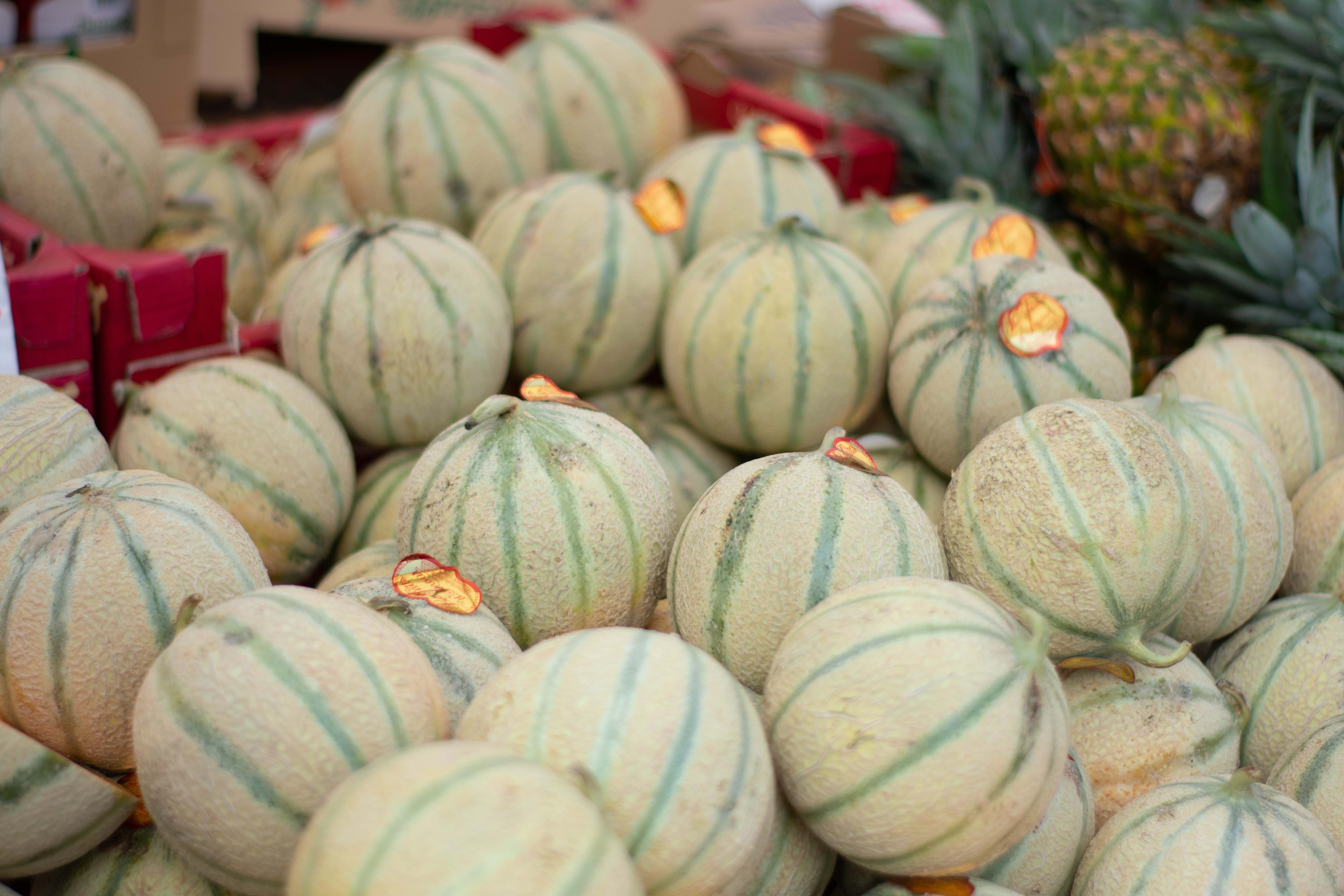
If you are familiar with French customs, you might know the Charentais melon. The Charentais melon, also known as the Cavaillon melon or the French cantaloupe, reaches an average of 7 to 10 cm in diameter, weighing about 2 to 3 lbs. Most Charentais melons have circular or oval shapes. Its rind is thin, hard, and ranges between grey to pale green with dark green stripes.
You can only find these types of melons during the summer up to early fall around the Northern Hemisphere. However, it is also possible to find Charentais melons being cultivated in the Southern Hemisphere.
The rural town of Cavaillon in France is famous for its Charentais melons. In fact, the Feria du Melon a Cavaillon, an internationally famous celebration, is an annual event where the locals and tourists in Cavaillon celebrate the Charentais melon. History shows that popes, royalty, and authors have favored the Charentais melon.
Crane Melon

Next on the types of melons is the crane melon, a delicacy you won’t find in just any supermarket. The crane melon is a pear-shaped fruit weighing between 4 to 7 lbs. Its outer layer has colors between pale green with dark green blotches and rusty orange. The crane melon is succulent, sweet, and firm. It also has a similar fragrance to honey, orange blossoms, and roses.
Oliver Crane invented the crane melon, hence its name. He produced the crane melon by cross-breeding the ambrosia melon, the Persian melon, the Japanese melon, and the white melon. According to Oliver’s descendant, Jennifer Crane, the crane melon has a distinct flavor because of the terroir where it’s grown. Since then, the Crane family has been cultivating crane melons for 160 years on their property where the unique soil needed is located.
Crenshaw Melon
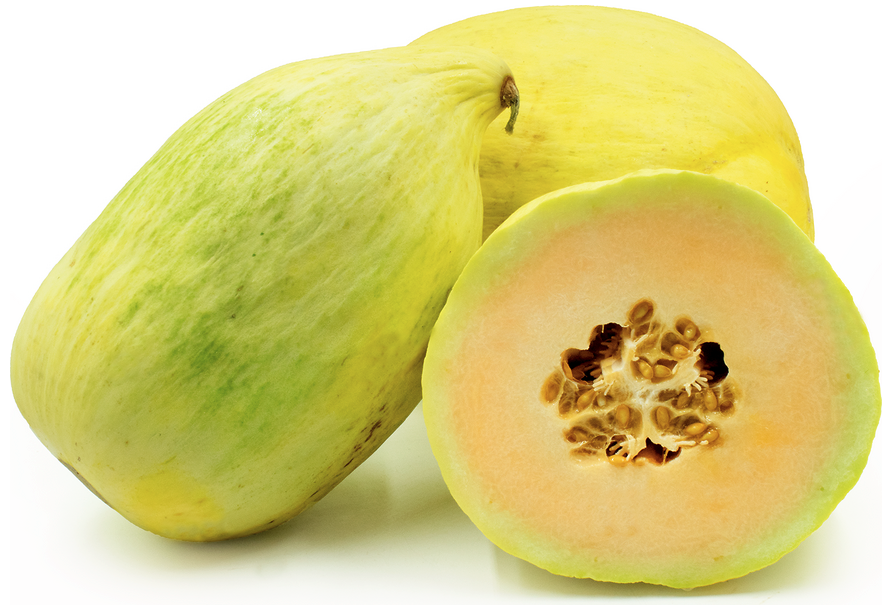
Crenshaw melons, which are around 17 to 20 cm in diameter, are acorn-shaped or oblong-shaped. They have a flat broad base with thick, hard rinds with colors between yellow with green streaks or a golden hue. Their flesh is orange or peach-colored, which has a mildly sweet flavor.
Just like the cantaloupes, Crenshaw melons have two varieties: the green Crenshaw and the white Crenshaw. While the green Crenshaw is rarer, botanists and gardeners adore the green Crenshaw melon for cultivation. The white Crenshaw is the more popular of the two, especially since it is more resistant to sunburn.
Historians believe that the Crenshaw melons are the product of crossbreeding between casaba and Persian melons from Turkey. By the 20th century, foreign trade introduced Americans to the Crenshaw melons and had their seeds sold around 1929. They became very popular, even having their own signature seasonally flavored brew by Banded Oak Brewing from Colorado.
Cucamelon
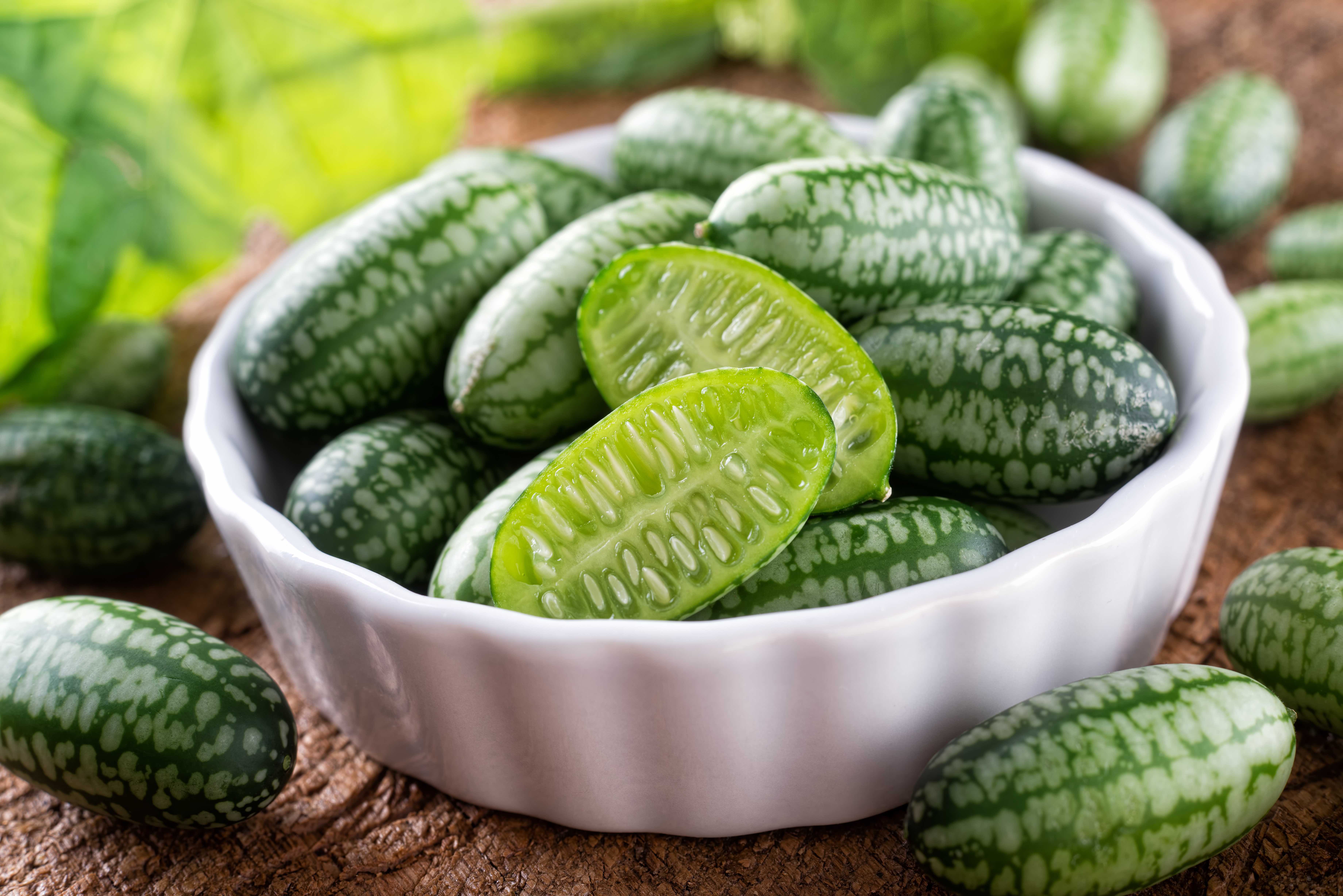
The cucamelons are one of the most popular types of melons because of their size. Cucamelons have tons of other nicknames such as the Mexican sour gherkin, the pepquinos, the Mexican sour cucumber, the mouse melon, and the Mexican miniature watermelon.
Cucamelons look like watermelons with their light pale green and dark green stripes. However, they have the same size as a grape. People who have consumed cucamelons say they taste like a sweeter version of cucumber.
Cucamelons originate from areas across Mexico and Venezuela. Indigenous folk had been eating these melons for years before the colonization of the West.
These melons are unavailable in conventional grocery stores, and they cost up to $26 a pound. Because of their expensive price, most people prefer to grow cucamelons in their own garden. Especially since they’re easy to grow and resistant to infestations or diseases. You may find cucamelon seeds in specialty shops.
Galia Melon
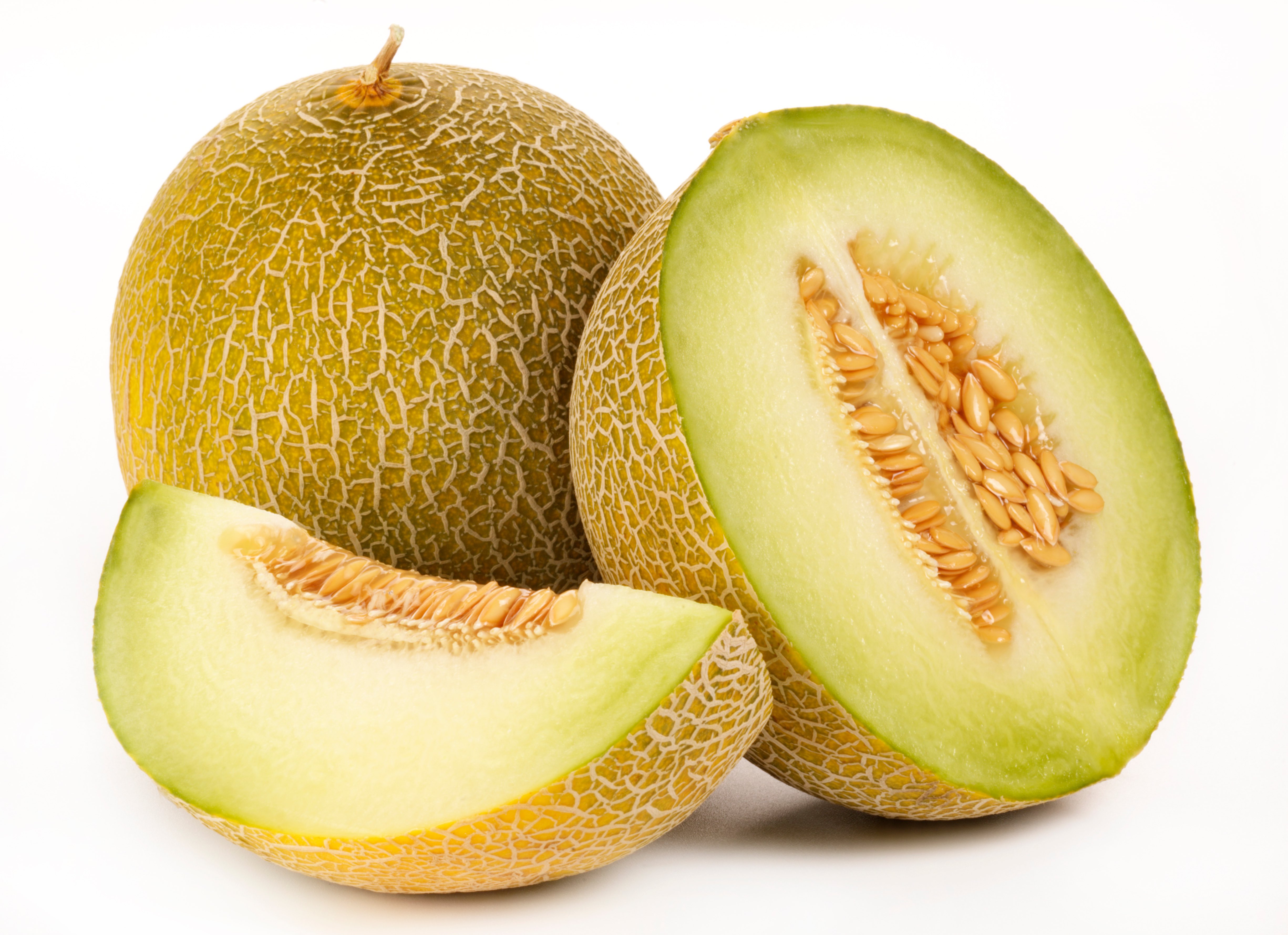
The Galia melons are one of the types of melons listed here belonging to the hybrid group. They are a product of crossbreeding the Ha-Ogen and Krimka melons in Southeast Asia. Galia melons are circular melons with netted skin, weighing an average of one kilogram per piece. Galia melons also change colors, from pale green to bright yellow colors at full maturity.
Dr. Zvi Karchi from Israel bred the melon at the Ne’ve Yaar Research Center of the Agricultural Research Organization. He released the melon in 1973, naming it after his daughter.
You can find Galia melons all over Algeria, Guatemala, Panama, Brazil, Honduras, Costa Rica, Morocco, Egypt, Turkey, Spain, Greece, Israel, and Portugal. This is because they are both easy to grow, sweet, firm, and can be left at room temperature without rotting easily.
Gac Melon
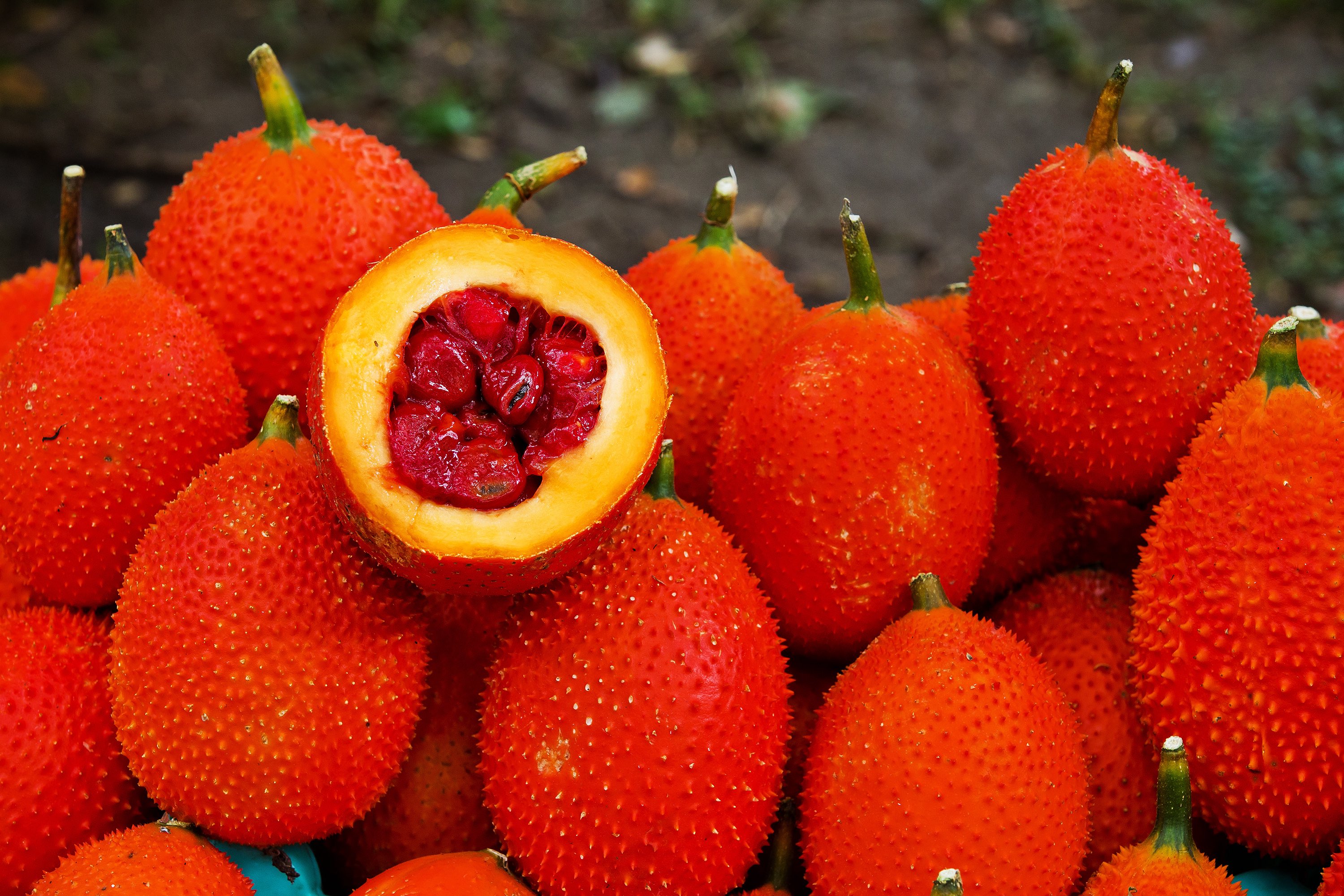
Gac melons, also known as baby jackfruits, sweet gourds, cochinchin gourds, or spiny bitter gourds, grow on dioecious vines. It is difficult to find gac melons out of season, especially since they only sprout once every year. Gac melons can come in two shapes: circle or oblong. Unlike most types of melons, gac melons have unique spines covering their dark orange skin. The flesh of the gac melon is also unique, with orange layers surrounding large dark red pulps.
Despite their loud appearance, gac melons have extremely mild flavors, similar to cucumbers. They contain 70 times higher amounts of lycopene (an antioxidant that promotes heart health and prevents cancer) compared to other types of melons and tomatoes. They even have carotene (which promotes eye health, strong immune systems, and healthy skin) 10 times more than carrots or sweet potatoes, making them a candidate for a healthy diet.
Golden Dewlicious Melon
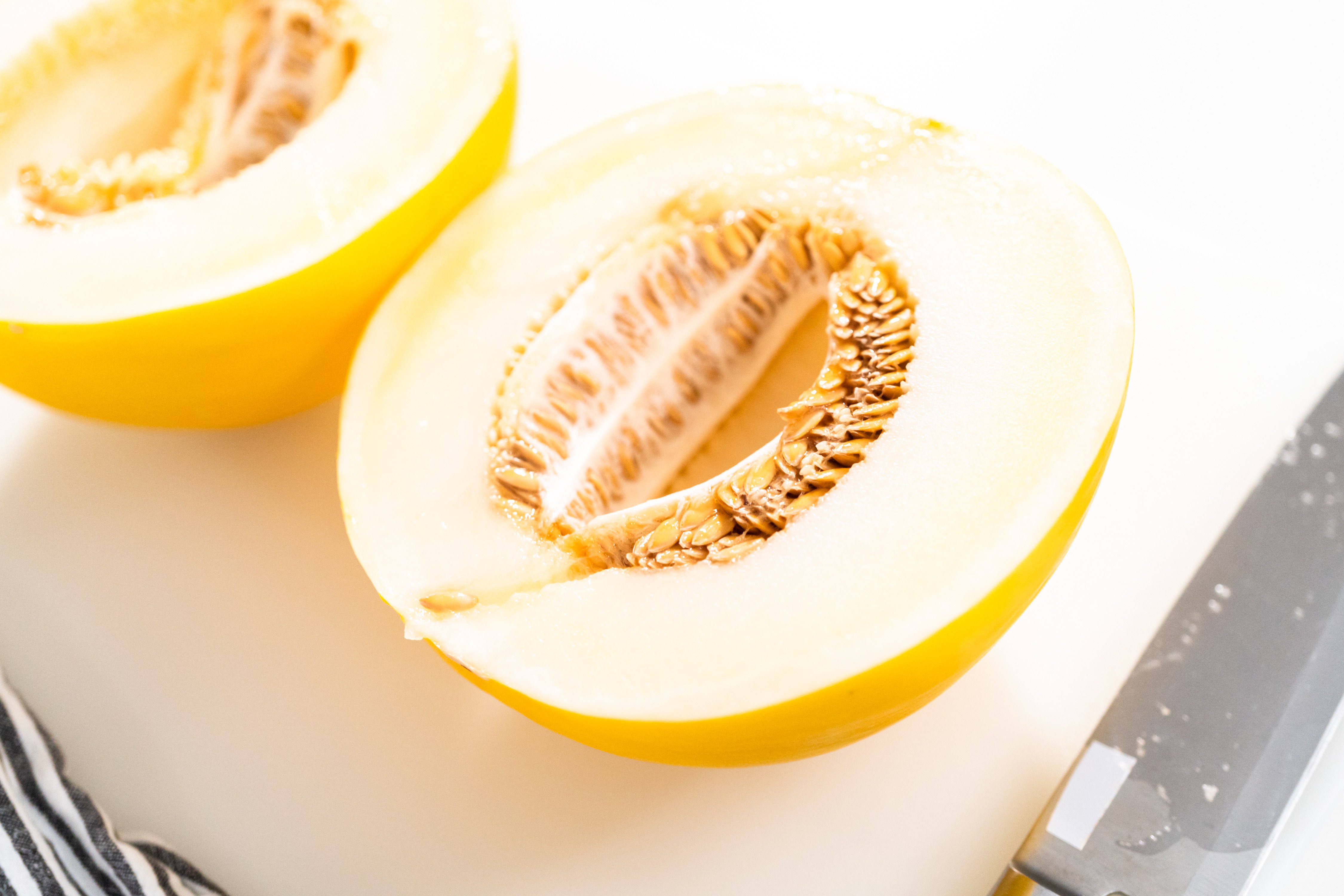
The golden dewlicious melon is a hybrid yellow honeydew fruit. You might also know them as the golden honeydew melon. These melons have an average size of 15 to 22 cm. They usually grow into round or oval shapes covered with firm and smooth rinds with shallow striations. They have white ivory flesh with pieces of pale green colors.
Golden dewlicious melons also have a fruity and floral fragrance around them, suitable for their sweet honey flavor. If you plan on growing your own, you should be aware that these melons need to be manually harvested since they rarely slip off their vines.
While they do sound delicious, you can only get golden dewlicious melons during the summer up to the early fall season. Fortunately, they are easily exported around the world, making it easy to find them in most markets during their seasonal harvest.
Golden Langkawi Melon
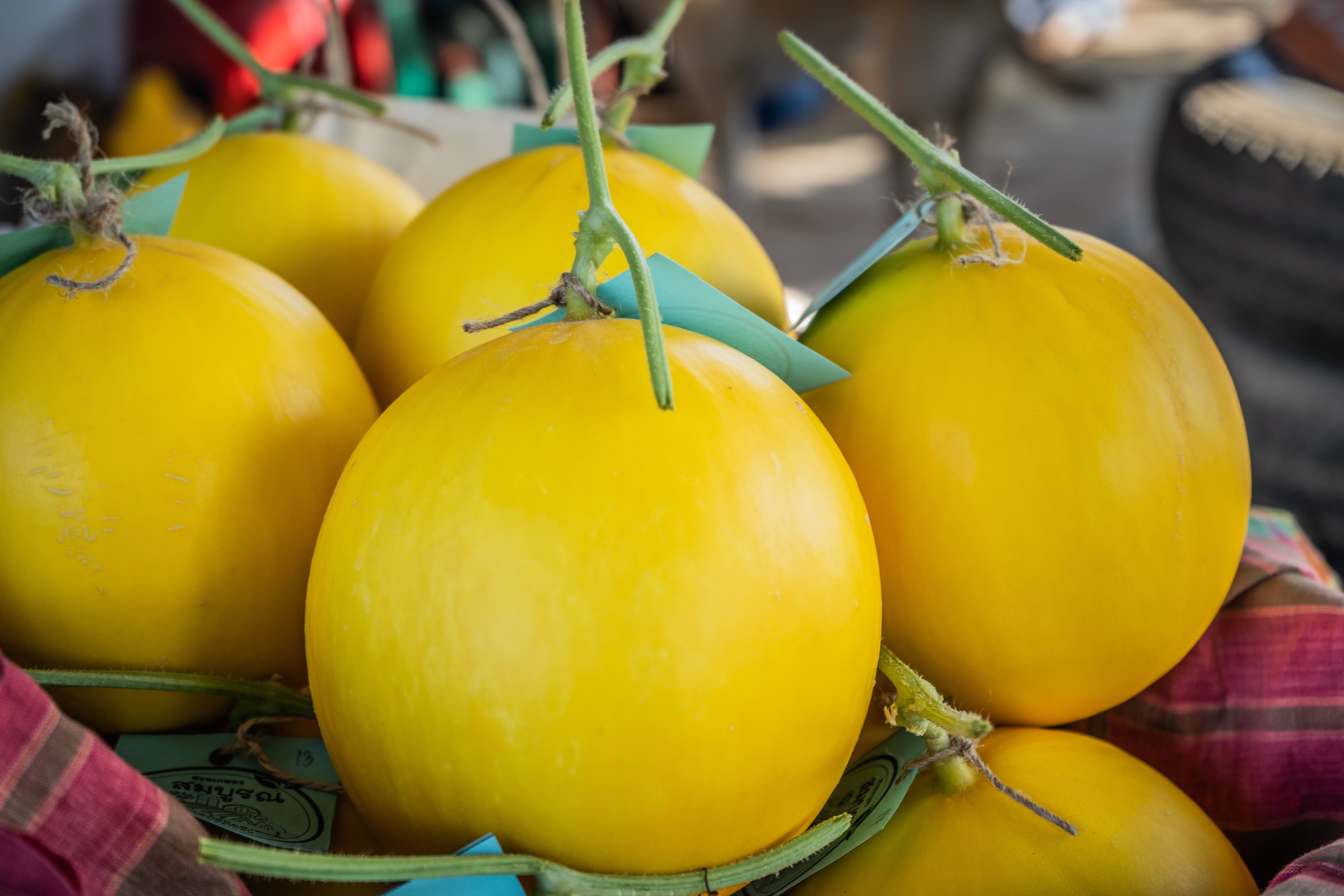
The golden Langkawi melon is next on our types of melons. This Asian melon comes from Langkawi, Malaysia. They weigh a maximum of six pounds with an elliptical-shaped body. When you bite into a golden Langkawi melon, the first thing you will notice is its crunchiness. The melon itself is high in both water content and sugar.
Golden Langkawi melons are originally white when unripened. However, by the time they reach maturity, the golden Langkawi melon skin turns golden.
These melons are perfect if you plan on planting some in your small home gardens as you can plant them in plastic pots or poly bags. In addition, they also have a short harvest time, giving you the chance to enjoy the melon in just 80 to 150 days after planting.
Golden Prize Melon

Golden prize melons are also one of the types of melons on our list with a golden color. The golden prize melon is oblong-shaped with orange-colored flesh. Most people describe the golden prize melons as slightly thick and crunchy, yet taste extremely sweet.
Golden prize melons indeed have thick skin. However, people consider this beneficial as this makes golden prize melons easy to store for long periods without it going bad. They are also easy to export to long trade routes since they remain fresh despite the distance.
Hami Melon
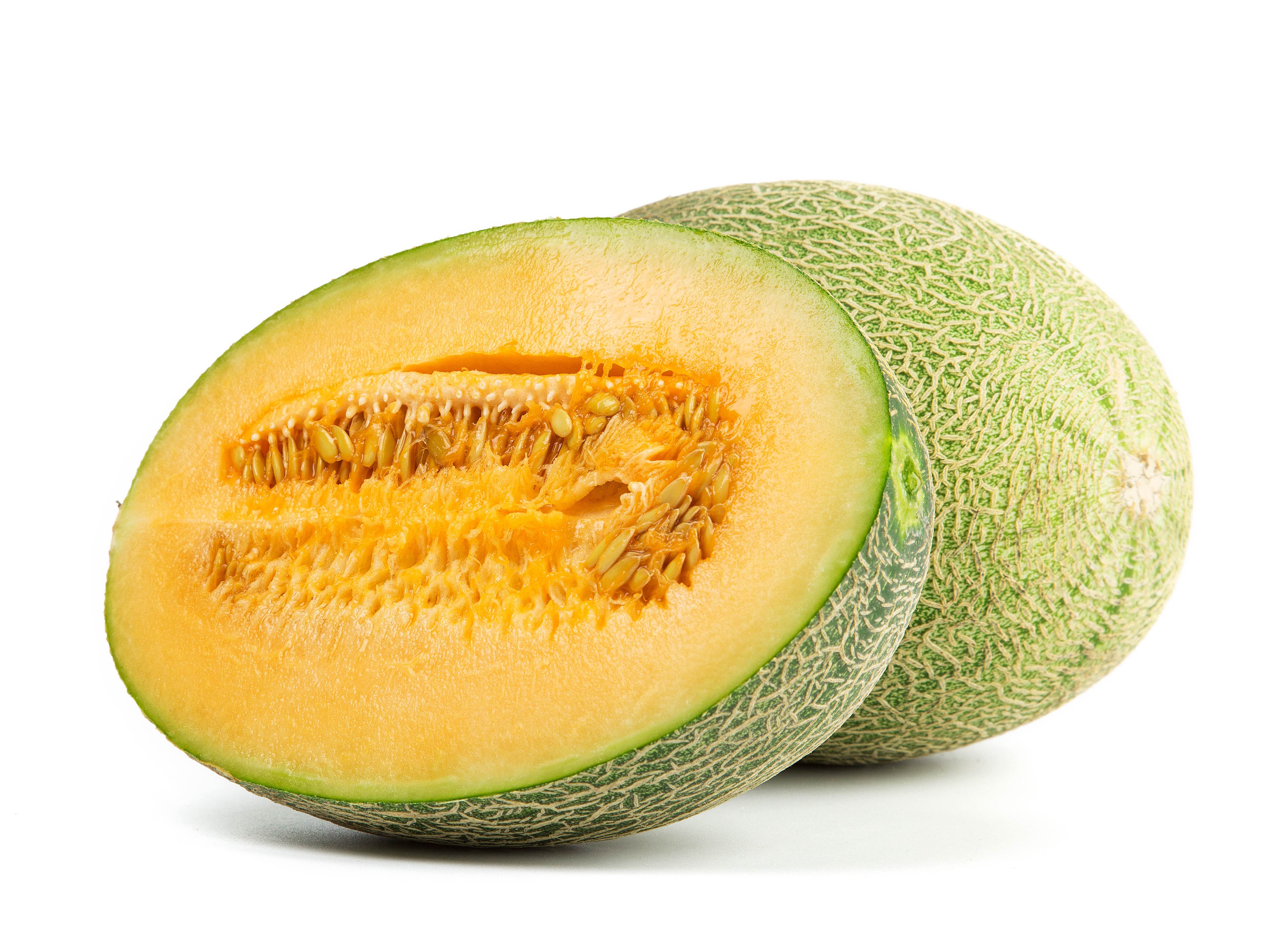
The Hami melon, also known as the snow melon or the Chinese Hami melon, is a type of muskmelon that was first cultivated in Hami, Xinjiang, China. It has a beautiful outer layer with white, pink, yellow, or green colors. Meanwhile, its flesh is crispy sweet.
Hami melons have become a staple in most Asian countries thanks to globalization and trade. Hami melons are a perfect treat during hot weathers such as summers and droughts. Thanks to its benefits, you can now find at least 100 cultivated Hami melon varieties because of selective breeding worldwide.
Despite their popularity in Asia, you may find it difficult to purchase them in the United States. There are limited stocks of the Hami melons in the western states such as Arizona and California. Crossing the border for a trip to Mexico is also a great way to get a taste of the Hami melons.
Honey Globe Melon
Now, a honey globe melon might be something unfamiliar to you. This type of melon is a rare find in North America. Honey globe melons originate from Southeast Asia. They sprout in shorter seasons compared to other types of melons. As a result, it is difficult to harvest many of them.
Honey globe melons are very sweet with their 20% sugar content being one of the highest for melons. They also have an attractive appearance with their white outer layer similar to Bailan melons or honeydew melons. They have white succulent flesh inside.
Honeydew Melon
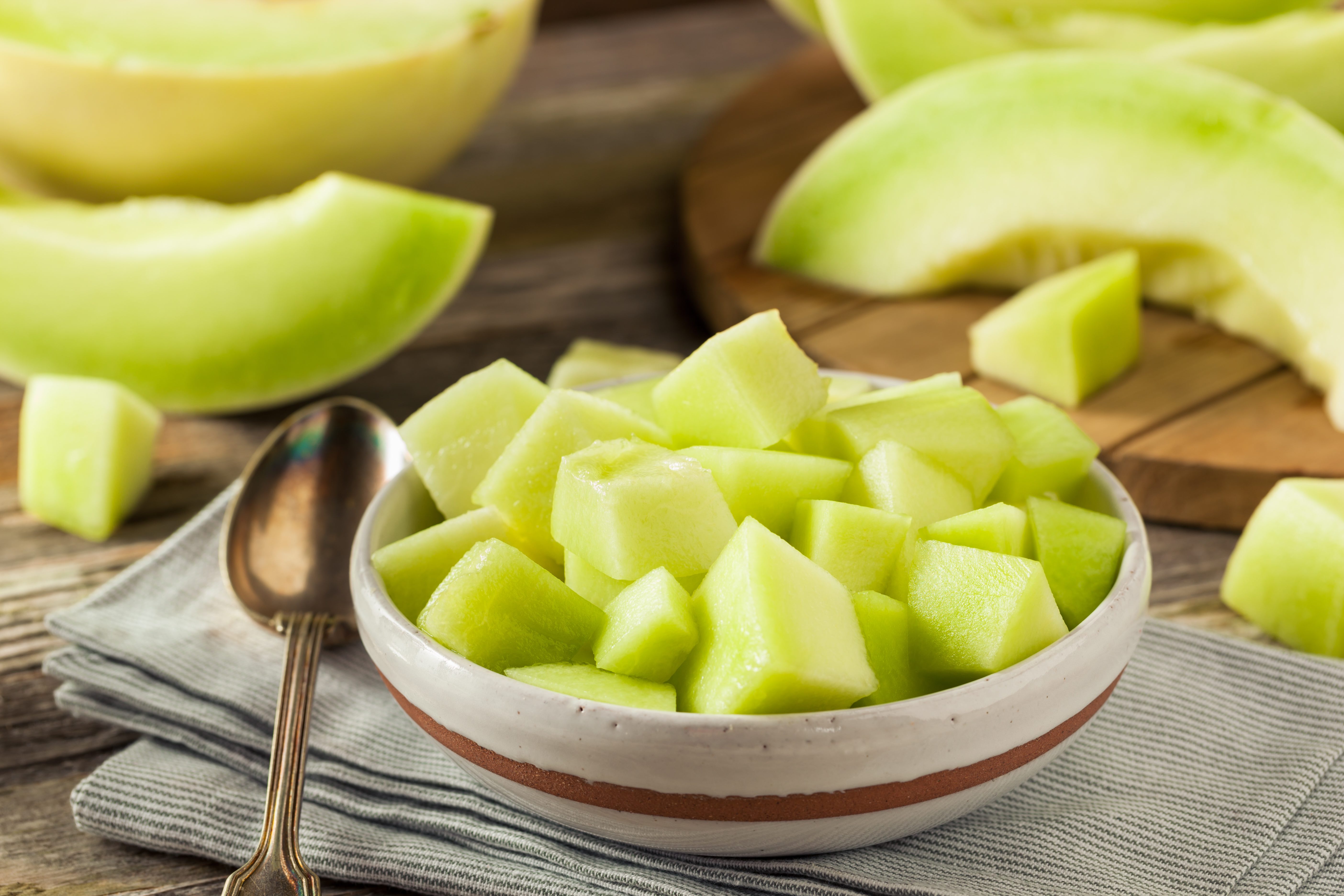
Honeydew melons are one of the most popular types of melons in the world. People who consume honeydew melons enjoy them at their sweetest, which is achieved when the honeydew melon ripens on the vine itself.
Honeydew melons are a type of muskmelon, which means it belongs to the sweeter group of melons. You can also call honeydew melons by their other nicknames, such as “honeydews” or “Honeymelons.”
Honeydew melons normally have an oval shape with an average length of 5 to 8 inches. They have pale green flesh with greenish to yellow outer skins. Just like most sweet melons, people consume honeydew melons for dessert and are widely popular during their harvesting season from August to October.
If you plan on growing your own garden of honeydew melons, take note these melons prefer semiarid climates. They prefer rather dry areas compared to other types of melons. You should also harvest honeydew melons based on their maturity and not their size. Their maturity is based on the color of their ground, which can range from green and white to cream and yellow.
Horned Melon
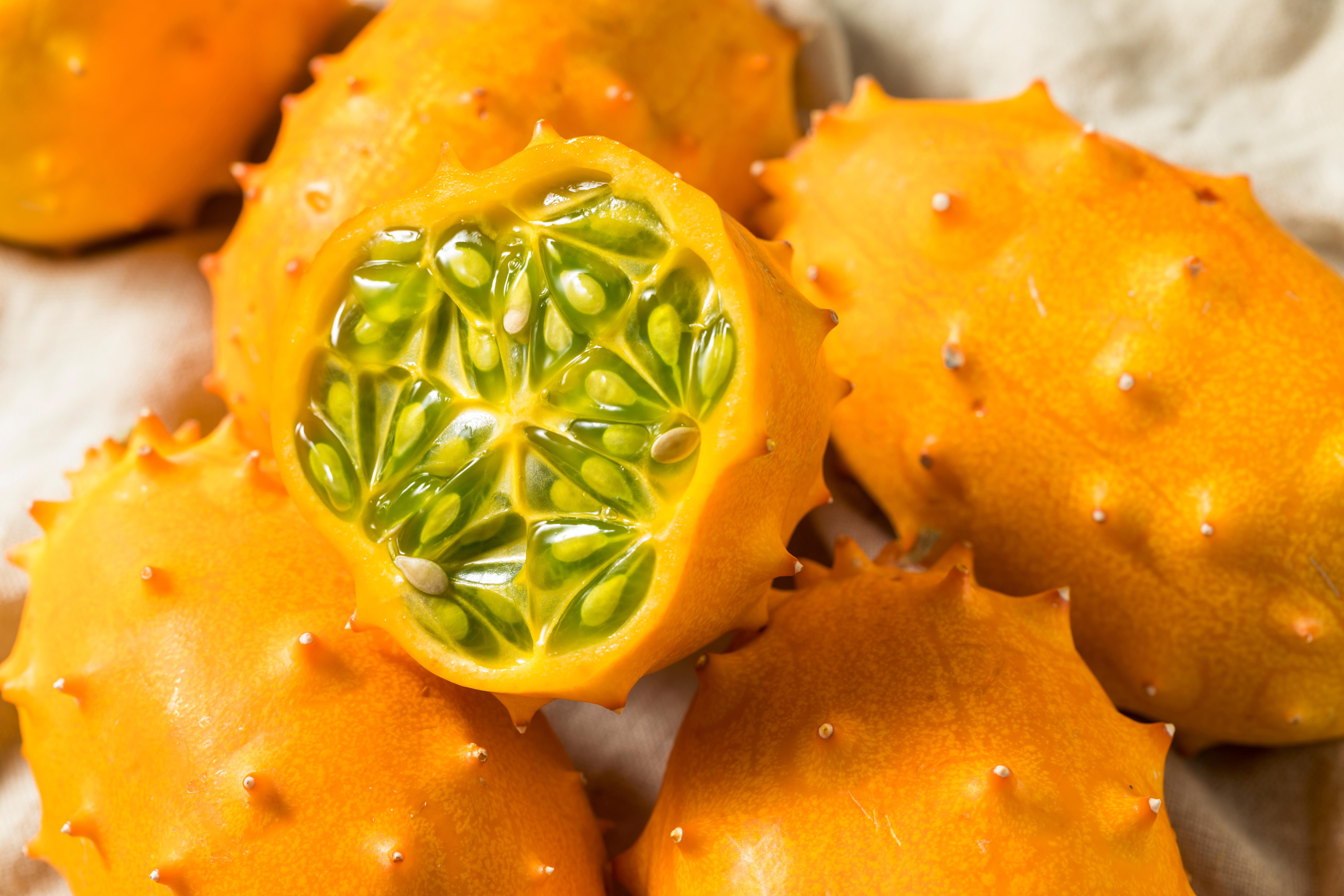
The horned melon, also known as the Kiwano melon, the African horned cucumber, the cuke-a-Saurus, the jelly melon, and the spiked melon, is an exotic fruit native to the southern and central parts of Africa.
The horned melon has yellow skin with spikes covering its entire body, hence its name. Inside the horned melon is its vibrant lime green or yellow flesh filled with edible seeds. While the horned melon is consistently edible during any of its ripened stages, it is important to note that it will burst out forcefully to release its seeds once overripe.
People who have tasted horned melons describe its taste as a cross between bananas, cucumbers, zucchinis, passion fruits, and lime. You can even consume the peel of the horned melon, which has Vitamin C and dietary fiber.
Horned melons, along with the Gemsbok cucumber and the Tsamma melon, are one of the very few water sources for the Kalahari desert. Because of this, many African cultures consider the horned melon as traditional food eaten by ancestors.
Jade Dew Melon
The jade dew melon follows next on our types of melons list. Here we have a round-shaped melon weighing a maximum of 2 kilograms. It has pale green skin with semi-webbing surrounding it. However, if exposed to the sun, their skin can turn into a darker shade of green. The insides of the jade dew melon are a milk-like yellow with sweet flavors (thanks to its 14 to 16% sugar content) and a crunchy texture.
Jade dew melons are uniquely resistant against many plant diseases, viruses, and pests. This makes them a favorite for home garden planting. However, it is important to note that jade dew melons thrive on being planted in highland climates.
Kantola Melon
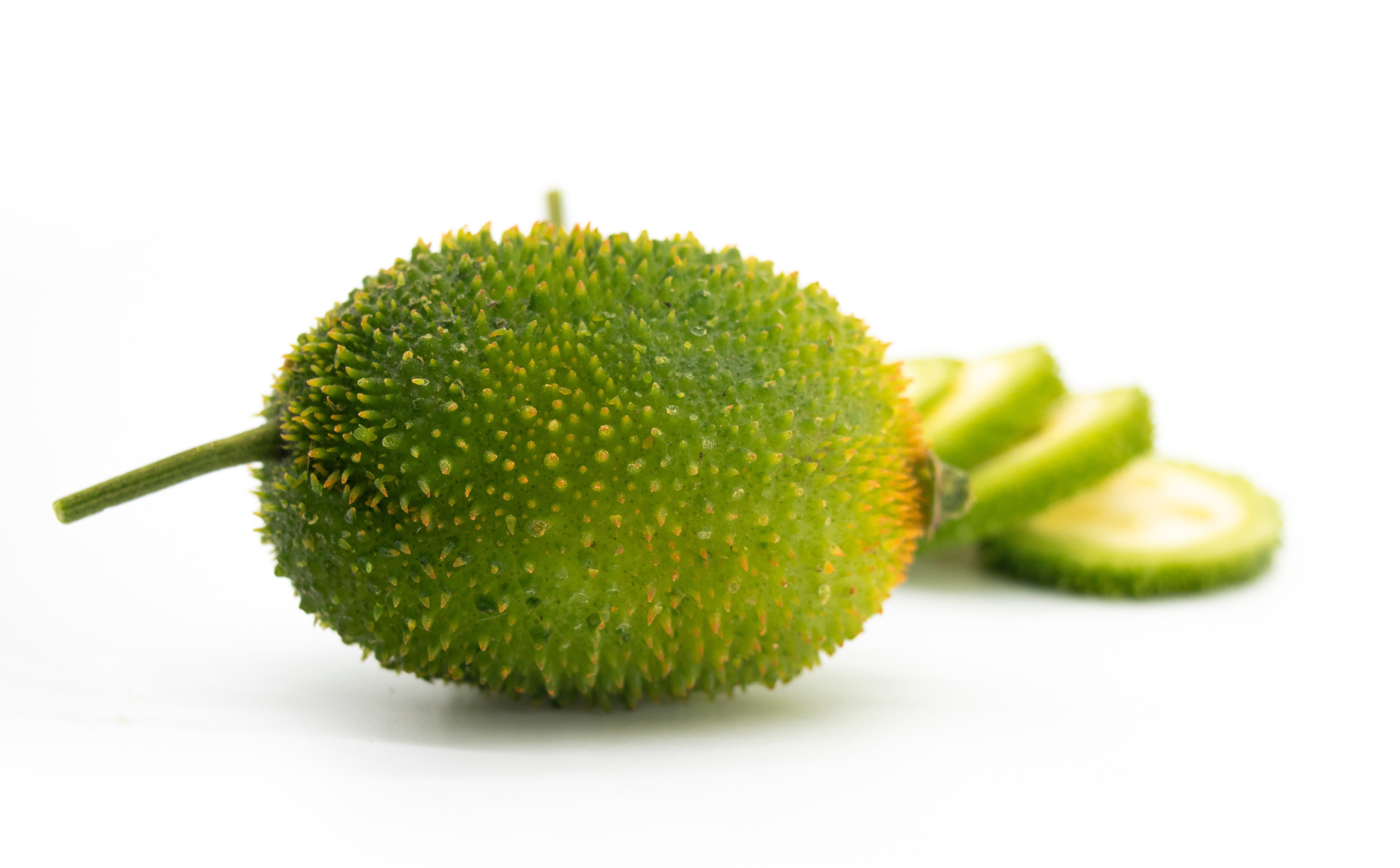
Here we have the Kantola melon, also known as the spiny gourd, bristly balsam pear, prickly carolaho, teasle gourd, or thumba. While it may have melon-like properties, there have been continuous debates about whether a Kantola melon is more melon or gourd.
Kantola melons have deep green skin covered with spines. Its inside flesh ranges from pale yellow to dark yellow. Kantola melons are also uniquely small, reaching the average size of 2 to 4 cm (about as large as your average lemon.)
You can find Kantola melons growing in India and other South Asian regions. This is because they are delicious ingredients used to add flavors to meat or fish recipes. It also contains high traces of folates, Vitamin C, and fiber. Because of their health benefits, Kantola melons are used to regulate blood pressure, prevent infections, promote eye health, maintain a healthy weight, prevent kidney stones, and ease some skin problems.
Kiss Melon

Sugar kiss melons belong to the kiss melon family, which are hybrids of Hami melons. There are three types of kiss melons: summer kiss, kiss Limon, honey kiss, and sugar kiss.
Sugar kiss melons are the sweetest of the hybrids. You can expect the flesh of the sugar kiss to melt in your mouth like sugar melting on your tongue. The best part? Sugar kiss melons are non-GMO too. You can also find the sugar kiss melon harvest around mid-June to end-October.
Meanwhile, summer kiss melons are creamier and more mellow compared to sugar kiss melons. You can find summer kiss melons all over the world. However, it was Israel that first created the original summer kiss melon hybrid. You can harvest the summer kiss melons from early June to late October.
The honey kiss melon is another variety of Hami melon originating in China. Just like the sugar kiss melon, the honey kiss melon is extremely sweet. Honey kiss melons have the fragrance of sweet honey coming out of them, as its name suggests.
Finally, the kiss Limon melon is another type of kiss melon. However, unlike the others we discussed, kiss Limon melons have sweet lemonade flavors. This makes them easy to eat on their own. However, you must eat them within three days after cutting them open.
Korean Melon
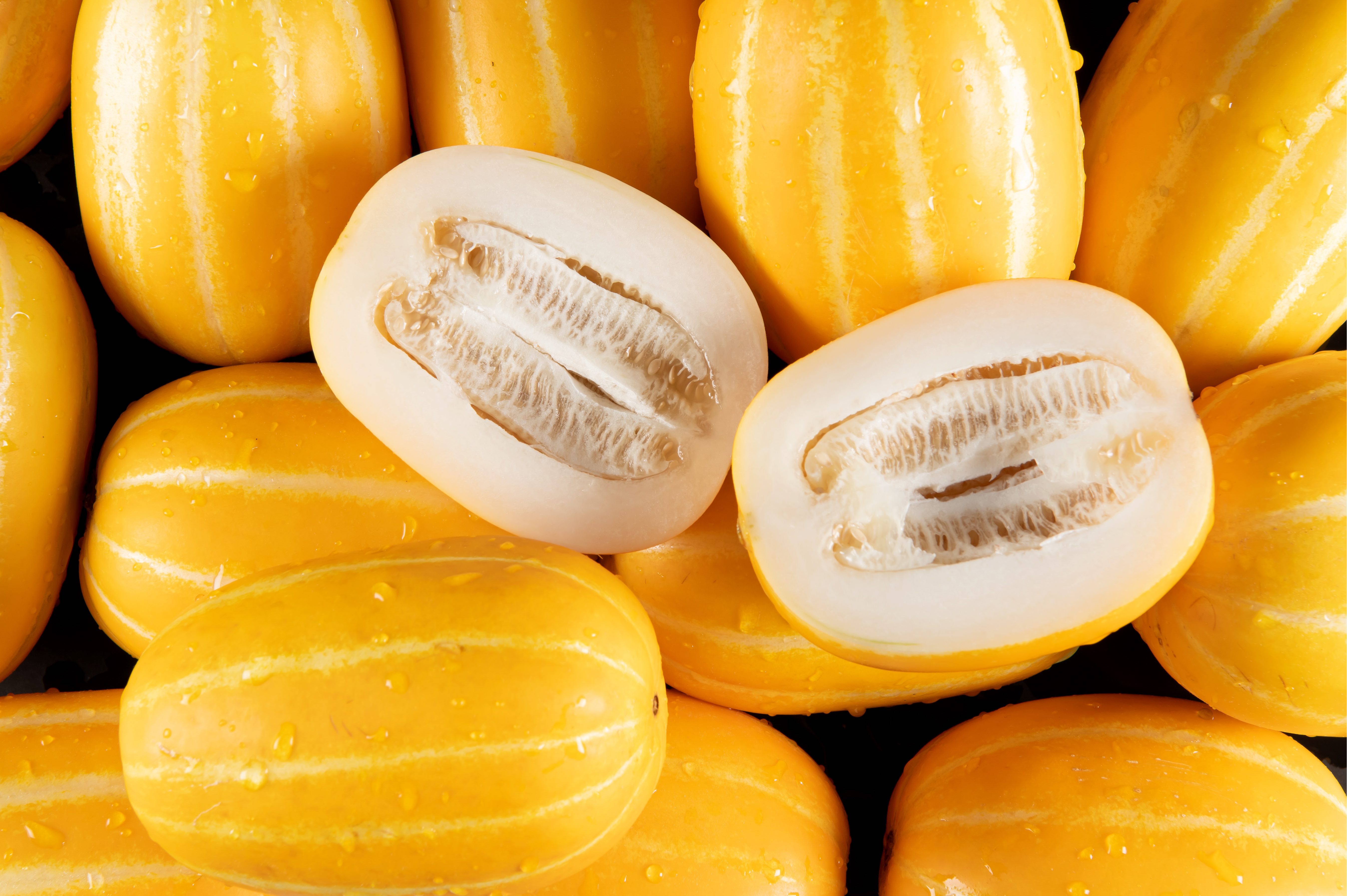
The Korean melon is one of the types of melons that were first cultivated in East Asia. The Korean melon has many nicknames depending on each country. The Ancient Chinese used to call this melon the tian gua, which means sweet melon. However, modern Chinese usually call it xiang gua, which means fragrant melon.
Koreans call the Korean melon by another name as well, chamoe, which means true or real cucumber melon. Koreans love to consume Korean melon during summer. They create side dishes called chamoe-jangajii, which are pickled Korean melons with spices. If you want to get a taste of these dishes, we recommend going to the Seongju County of South Korea, a place known for cultivating 70% of all the Korean melons in the country!
The Japanese call these melons as makuwa uri, regarding the village of Makuwa that was known for their oriental melons in the 2nd Century AD. However, they prefer to offer them during the Bon Festival, which commemorates their departed ancestors. Other than offerings, unripened Korean melons are also used to create tsukemono, a Japanese pickled dish.
Maroon Cucumber Melon

The maroon cucumber melon, also known as the West Indian gherkin or gourd, the cackrey, the maxixe, or the burr gherkin, is an indigenous fruit from Africa. However, the maroon cucumber melon has already become a naturalized fruit in the New World.
Maroon cucumber melons come from herbaceous vines which are thinly stemmed and can reach 3 meters long. Maroon cucumbers are oblong or ovoid-shaped melons with an average size of 4 cm, making them around the same size as cucamelons. However, unlike the cucamelons, maroon cucumber melons have spines and bumps covering their skin.
Maroon cucumber melons are indigenous only in Africa. You can find them in the Democratic Republic of Congo, Malawi, Angola, Mozambique, Botswana, Namibia, Zimbabwe, Zambia, Tanzania, Swaziland, and parts of South Africa.
New Century Melon
New century melons belong to our hybrid types of melons in this list. They are a variant of the Chinese Hami melon that was first cultivated in Taiwan. New century melons are oblong-shaped with light yellow to green outer layers. They have few visible nettings covering their skin. Meanwhile, the inside flesh of the new century melon is light orange.
The new century melon weighs an average of 1.5 kg. People describe the new century melon as having crispy, tender, and sweet flavors. This is an accurate description, seeing as the new century melon has a sugar content of 14%. Additionally, the new century melon is perfect for export and import trade. They are durable enough for long-distance shipment, longtime storage, and are resistant to many plant diseases.
Persian Melon
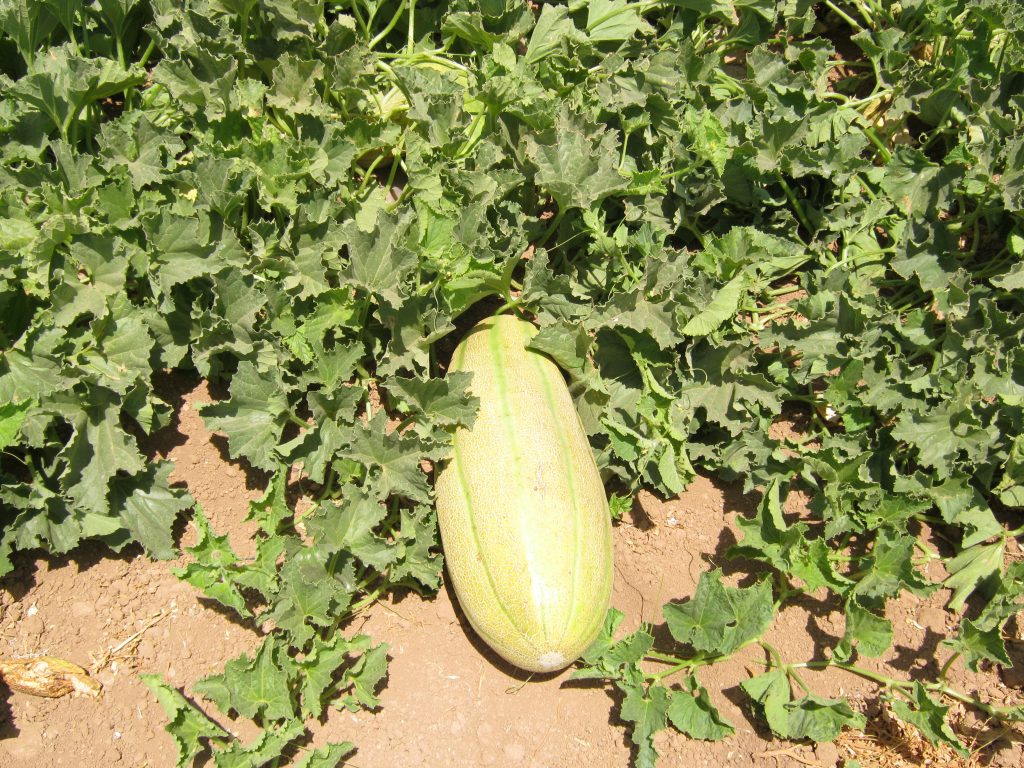
The Persian melon, also known as the Odessa melon, is next on our types of melons list. While they may have a similar appearance to the cantaloupes, Persian melons can come in different sizes and colors. The difference between cantaloupes and Persian melons is that Persian melons are larger.
Persian melons also taste similar to cantaloupes, but with a distinctively milder taste. Persian melons also have a buttery texture and are unusually heavier when ripe.
It was the Persians who first cultivated and consumed the Persian melons. In the 17th century, early settlers arrived in America with the melon seeds. As a result, modern Persian melons have now been crossbred to create different melon varieties, such as honeydew, Canary, and Charantais.
Picasso Melon
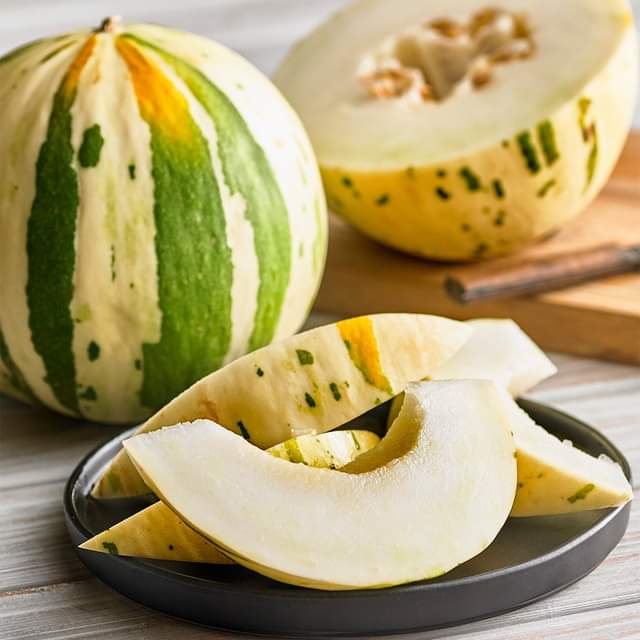
Picasso melons are one of the youngest types of melons listed here. After all, their cultivators just introduced them to the public in 2021. Daren Van Dyke, the director of marketing for Brawley and Five Crowns Marketing who released advertisements for the melon, received many calls from their clients asking about the melons. This resulted in Van Dyke gathering enough reports to assure positive reviews of the Picasso melon.
Picasso melons have vibrantly white skin with green fading spots in between. The inside flesh of the Picasso melons is also uniquely white. However, they remain sweet with an aftertaste similar to cucumber.
Van Dyke described them as having a beautiful appearance that looks like the cultivators painted it with watercolors. As a result, they named the Picasso melon after the famous painter Pablo Picasso.
Snapmelon
Snapmelons are native fruits from India. They remain widely mass-produced in the country. This is because they are edible regardless of whether they are cooked or raw. Additionally, snapmelons are also resistant to nematodes, insects, viral diseases, fungus, and can survive under drought conditions. Snapmelons are also a great source of high fruit acidity. As a result, their useful traits have been used in international melon breeding programs to create hybrid sweet melons.
Snapmelons can come in a wide variety of shapes: round, elliptical, elongated, acorn-shaped, and many more. The flesh of the snapmelons vary from cream, yellow, and orange. Immature snapmelons are eaten raw, pickled, dehydrated, or cooked. Meanwhile, the seeds are used for a traditional drink called “thandai”
Select Rocket Melon
Select rocket melons are native to New Zealand. However, scientists also biologically engineered them to serve as a substitute for sky rocket melons and support their increase in demand. The reason for select rocket melon’s existence is because of a shortage of sky rocket melons in the late 1990s. While the shortage has long since passed, select rocket melons remain cultivated worldwide.
Just like the sky rocket melon, select rocket melons have green skin with sweet flavored green flesh inside.
Sky Rocket Melon
The sky rocket melon seeds come from Germany and Taiwan. However, they are mostly cultivated in Indonesia. These melons are circular with thick green skin. Meanwhile, their flesh color varies from greenish-yellow to green with sweet flavors.
While the sky rocket melon may sound like a member of the hybrid group, scientists did not genetically change them. Sky rocket melons are a product of epigenetics, wherein the melon’s gene expression is modified through a natural hereditary process.
New Zealand was the first to distribute the sky rocket melons internationally. However, you can also find them in the United States within farmer’s markets. Sky rocket melon seeds are also available on the internet.
Sprite Melon
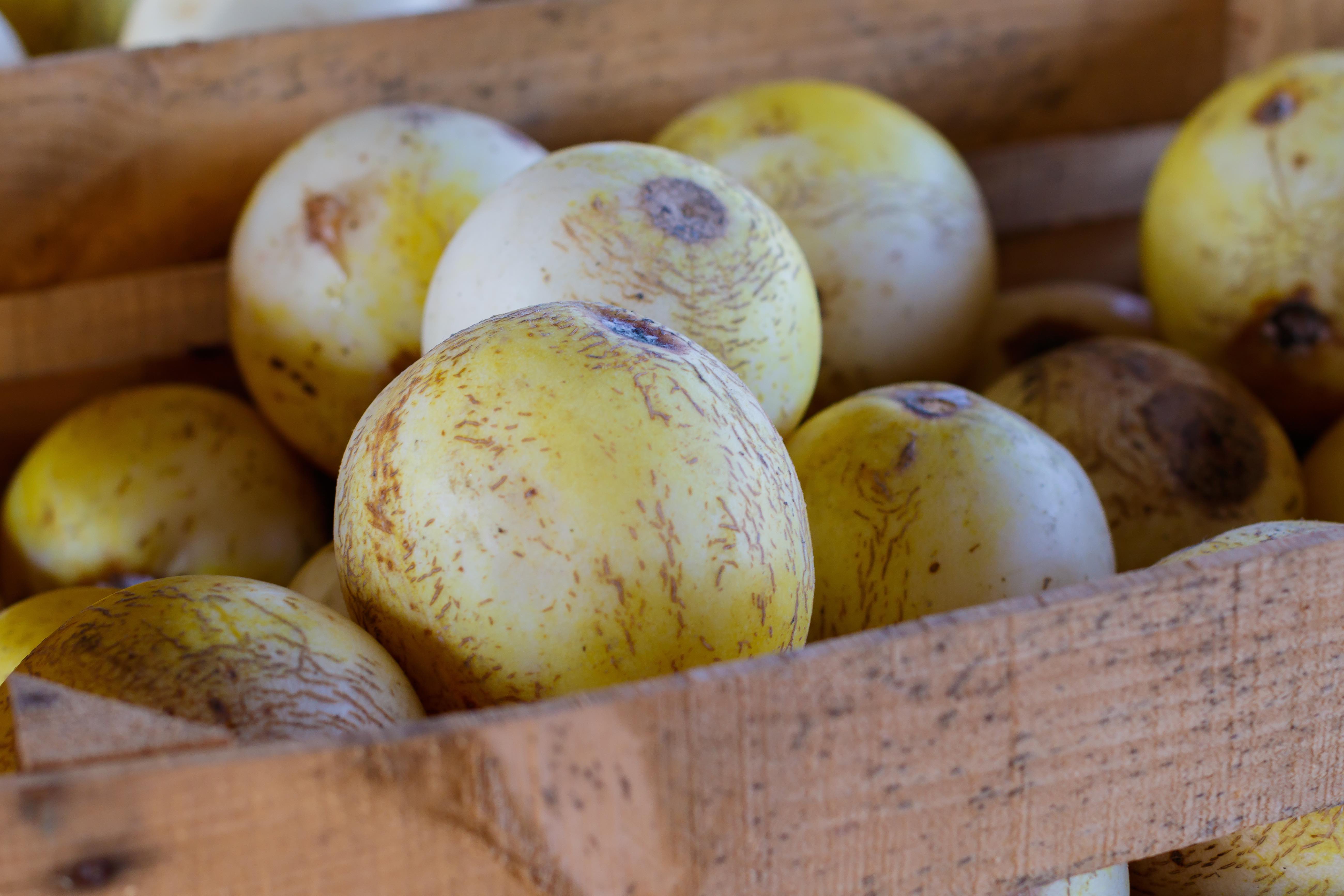
Sprite melons are another type of melon in Asia, originating in Japan. However, North Carolina has been cultivating the sprite melons as a specialty crop since the late 1990s.
What makes the sprite melon unique among the types of melons is its size. Local farmers’ markets sell the popular small melon in their stalls. They are easy to mass-produce, filled with sweet flavors, and their unique size garners marketable attention.
Sprite is as big as grapefruits with a circular shape. An average sprite melon weighs a pound with a measurement of 4 inches across. Its flesh is like an apple with its soft creamy colors. When ripened, sprite melons produce yellow patches on their skin and fall from the vines easier than before.
If you plan on starting your own melon garden, the sprite melon is a great melon to start with. This is because the vines of the sprite melon produce many melons in a single vine and reach maturity at an average of only 79 days.
Tsamma Melon
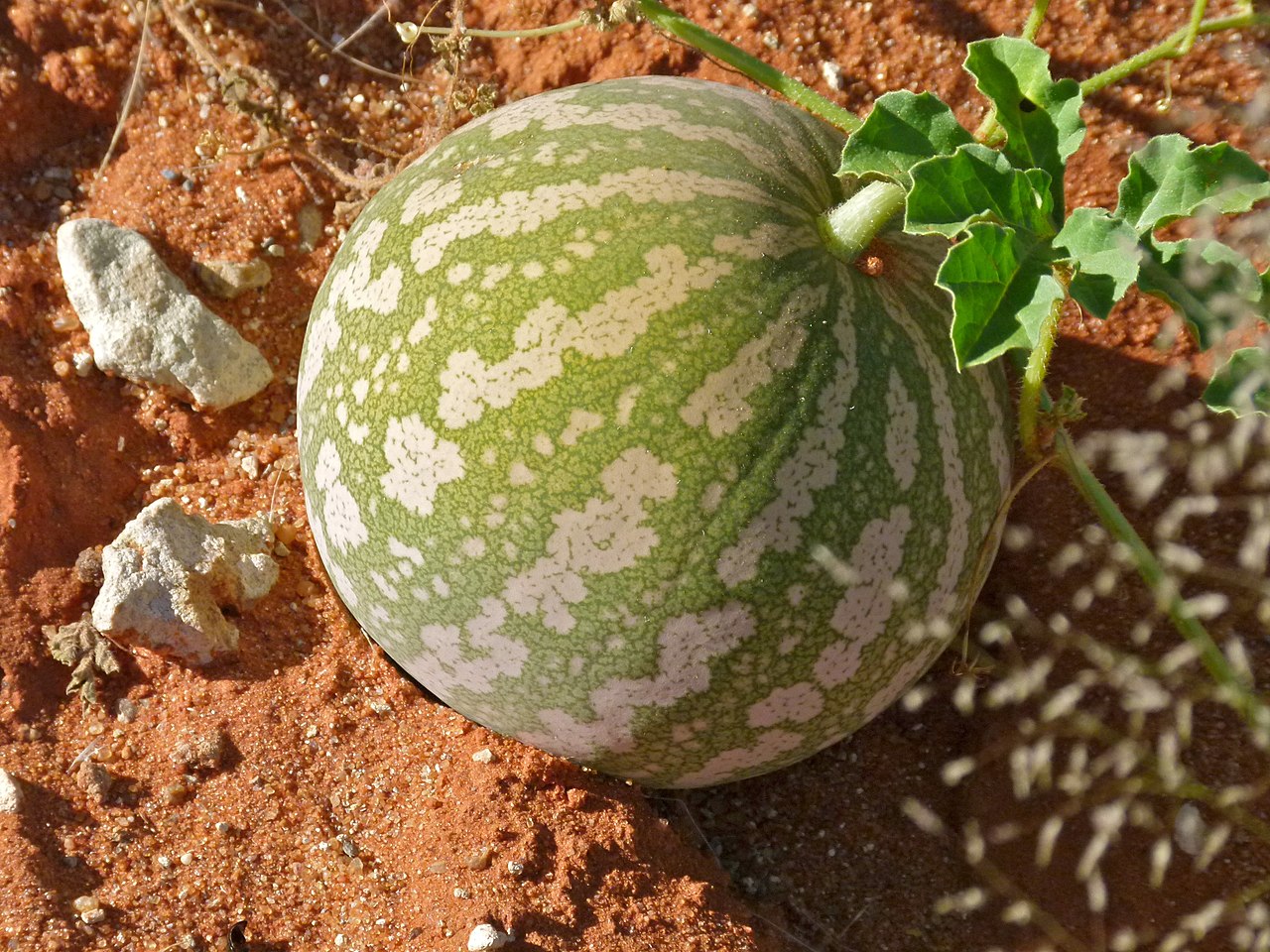
The Tsamma melon, also known as the Namib tsamma or the Citrullus ecirrhosus, is a perennial desert vine. You can find these melons growing in the Kalahari Desert, the Namib Desert, Namibia, and South Africa.
Tsamma melons have yellow flowers and vines that can spread up to 2 meters long. They are also strong enough to survive with little water and intense sunlight. This is because the Tsamma melons rely on the water deep in the ground and during the morning fogs.
Tsamma melons have a bitter taste similar to their sister species, the bitter melon. However, it remains a necessary plant for many living beings. Wild animals such as hyenas, ground squirrels, weaver birds, striped mice, and gemsbucks consume Tsamma melons as their source of water in the desert. You can also consume the Tsamma melon safely. In fact, the San people of Southern Africa believe a person can survive for six weeks on Tsamma melons alone.
Valencia Melon
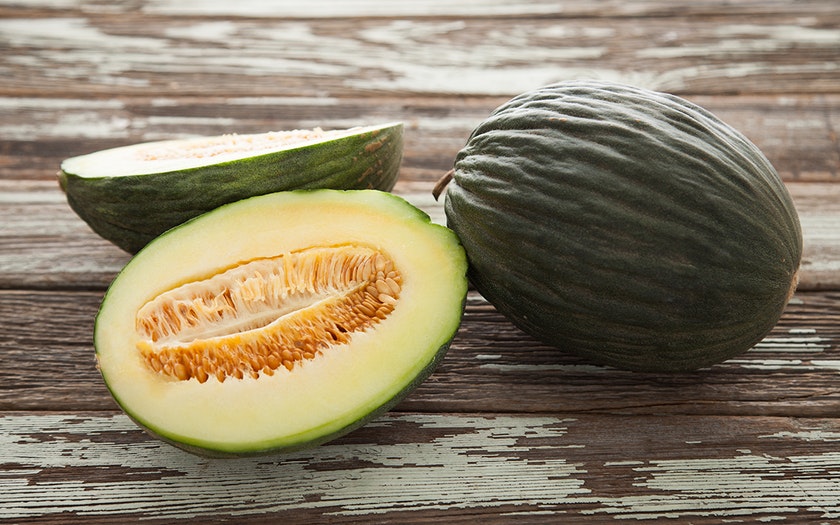
The Valencia melon is one of the oldest melons we listed here, as American seed merchants have listed the Valencia winter melon seeds around the 1830s. They noted how the Valencia melon is durable throughout winter and keeps its dark green skin and white flesh fresh for consumption.
The Valencia melon has many similarities with the Malta melon, like having the same outer and inner appearance, Thomas Jefferson also grew both in his Monticello garden. Farmers usually harvest the Valencia melons late into the year. Despite this, the melon becomes even more flavorful and sweet during its storage.
Watermelon

Perhaps the most famous type of melon in the world is the watermelon. Also known as the Citrullus Lanatus, the watermelon is a fruit low in calories and free of fat, yet flavorful and sweet. Its outer skin is light green, with dark green stripes surrounding it. The flesh of a watermelon is red with visible black seeds inside.
Reasonable consumption of watermelon is beneficial to your health since it contains traces of Vitamins A, B6, C, antioxidants, potassium, amino acids, and lycopene. Angela Lemond, the Texas-based spokesperson of the Academy of Nutrition and Dietetics, explains that both antioxidants and amino acids boost bodily function. Amino acids, in particular, are known as the basic building blocks of protein, which are used for vital functions in the body.
The U.S. Department of Agriculture discovered that a cup and a half of watermelon has an average of 9 to 13 mg of lycopene. This makes the watermelon contain 40% more lycopene than raw tomatoes, which are known to contain high amounts of lycopene.
The large quantities of lycopene in watermelon can help prevent prostate cancer, promote heart health, and protect bone health, as well.
Winter Melon

One of the types of melon famously used in milk tea is the winter melon. You can call the winter melon by its other names: the wax gourd, the ash gourd, the white gourd, or the winter gourd.
Winter melons have pale ash-like skin with light green flesh and dark green layers. They grow an average length of a foot and weigh a maximum of 40 lbs. While they may have the same oblong shape as a watermelon, we cannot eat them the same way. The proper recipes for cooking winter melons involve steaming, simmering, or parboiling them for consumption.
People possibly named winter melons for two reasons. The first reason could be because of harvesting and storage. Farmers grow winter melon seeds around the summer of the autumn season. However, they store them for months to be consumed in winter.
The second reason is because of the physical features of an immature winter melon. Winter melons that haven’t ripened have fine hairs all over their outer layer. They are fuzzy with a snow-like resemblance, hence their name.
Yubari King Melon

The last of our types of melons in the world is the Yubari King melon. This melon is a variant of the cantaloupe farmed specifically in Yubari, Hokkaido. The Yubari King is also a hybrid melon created from two other cantaloupe hybrids: Burpee’s Spicy Cantaloupe and Earl’s Favorite.
Yubari Kings are exceptional melons because of their perfectly circular shapes and smooth rinds. What’s even more interesting about the Yubari Kings is that they are the most expensive melon in the world.
A 2008 Japanese auction had two Yubari Kings sold at 2.5 million yen. Konishi Seika, a fruit and vegetable market, also bought a pair of Yubari Kings for 3 million yen around 2016. Pokka Sapporo Food & Beverage Ltd also bought Yubari kings in 2019 for the price of 5 million yen.
The reason for these expensive prices is how they were raised. The extensive care of all the farmers and agriculturists for the Yubari Kings has resulted in complete perfection, no blemishes, and wonderful flavors. As a result, people present the Yubari King melon as gifts as a sign of respect and goodwill.
Health Benefits of Melons
Melons are a healthy fruit to consume during diet. They are low in fat and calories while containing vitamins and minerals. Fresh melons such as watermelons, cantaloupes, and honeydews even contain 90% of water, which can satisfy a person’s thirst.
Cantaloupes are specifically beneficial for vision health. They contain a powerful antioxidant called carotenoids, which medical experts believe maintains eye function. In addition, they also have folates, which grow and maintain healthy cells.
Honeydew is also a good example of the health benefits of melons. They contain many key vitamins, such as Vitamin C, potassium, copper, and Vitamin B. These allow honeydew to provide you with a healthy immune system, good heart functions, and proper cell regeneration.
Conclusion
We hope you enjoyed learning about the different melons we have listed for you. Do you have a favorite among them?
While there are different melons in the world, all of them have become a staple for scientific progress, delicious recipes, and cultural traditions. Each melon is special and some are even perfect for you if you plan on growing your own melon tree. Just remember to be aware of the specific needs of each melon fruit. Meanwhile, if you are searching for some melon types to add to your new recipe, don’t forget to consider the unique flavors they can bring to your dish. Being curious about melon fruits is also not a bad idea. Who knows? Maybe this interest in melons can jumpstart your home garden or a new business idea or inspire you to create your own super melon dish!
Regardless of your intentions in learning about the different types of melons in the world, we can all agree that they are some of the most useful and tastiest types of fruits ever. Have a break from your daily life and enjoy one!
Was this page helpful?
Our commitment to delivering trustworthy and engaging content is at the heart of what we do. Each fact on our site is contributed by real users like you, bringing a wealth of diverse insights and information. To ensure the highest standards of accuracy and reliability, our dedicated editors meticulously review each submission. This process guarantees that the facts we share are not only fascinating but also credible. Trust in our commitment to quality and authenticity as you explore and learn with us.


